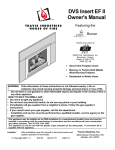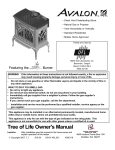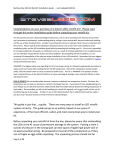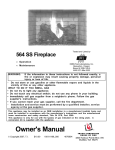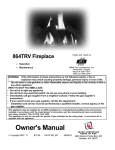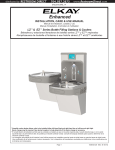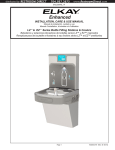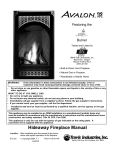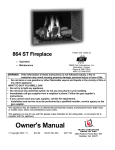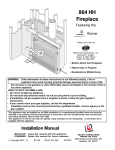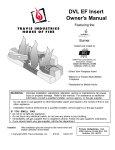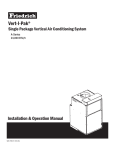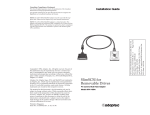Download Avalon Stoves DVL Insert EF II User's Manual
Transcript
DVL Insert EF II
Owner's Manual
Featuring the
Burner
Tested and Listed by
OMNI-Test Laboratories, Inc.
Beaverton, Oregon
Report # 028-F-72-5
ANSI Z21.88
•
Direct Vent Fireplace Insert
•
Masonry or Factory Built (Metal)
Wood-Burning Fireplace
•
Residential or Mobile Home
WARNING: If the information in these instructions is not followed exactly, a fire or
explosion may result causing property damage, personal injury or loss of life.
- Do not store or use gasoline or other flammable vapors and liquids in the vicinity of this or
any other appliance.
WHAT TO DO IF YOU SMELL GAS
• Do not try to light any appliance.
• Do not touch any electrical switch; do not use any phone in your building.
• Immediately call gas supplier from a neighbor's phone. Follow the gas supplier's
instructions.
• If you cannot reach your gas supplier, call the fire department.
- Installation and service must be performed by a qualified installer, service agency or the
gas supplier.
This appliance may be installed as an OEM installation in a manufactured (mobile) home and must be
installed in accordance with the manufacturer’s instructions and the manufactured home construction
and safety standard, Title 24 CFR, Part 3280.
This appliance is only for use with the type(s) of gas indicated on the rating plate. A conversion kit is
supplied with the appliance.
Installer:
After installation give this manual to the home-owner and
explain operation of this heater.
Copyright 2008, T.I.
$10.00
100-01174_002
4080123
Travis Industries, Inc.
4800 Harbour Pointe Blvd. SW
Mukilteo, WA 98275
2
Introduction
Introduction
We welcome you as a new owner of a DVL Insert. In purchasing this fireplace insert you have
joined the growing ranks of concerned individuals whose selection of an energy system reflects
both a concern for the environment and aesthetics. It is one of the finest home heaters the world
over. This manual will explain the installation, operation, and maintenance of this heater. Please
familiarize yourself with the Owner's Manual before operating your heater and save the manual for
future reference. Included are helpful hints and suggestions that will make the operation and
maintenance of your new heater an easier and more enjoyable experience. We offer our continual
support and guidance to help you achieve the maximum benefit and enjoyment from your heater.
Important Information
No other DVL Insert has the same serial number as
yours. The serial number is below and to the left of
the gas control valve.
This serial number will be needed in case you
require service of any type.
Register your warranty online at:
traviswarranty.com
Or, mail your warranty card to:
Travis Industries House of Fire
4800 Harbour Pointe Blvd. SW
Mukilteo, WA 98275
Save Your Bill of Sale.
Model:
DVL Insert EF II
To receive full warranty coverage, you will
need to show evidence of the date you
purchased your heater. Do not mail your
Bill of Sale to us.
Serial Number:
We suggest that you attach your Bill of
Sale to this page so that you will have all
the information you need in one place
should the need for service or information
occur.
Purchase Date:
Purchased From:
© Travis Industries
4080123
100-01174_002
Table of Contents
Introduction and Important Information
Finalizing the Installation
Introduction ......................................................2
Glass Frame Removal and Installation .................20
Log Set Installation............................................22
Steps for Finalizing the Installation.......................24
Pilot Flame Inspection .......................................24
Air Shutter Adjustment .......................................24
Safety Precautions
Safety Precautions ............................................4
Features & Specifications
Features ..........................................................6
Installation Options............................................6
Heating Specifications .......................................6
Dimensions ......................................................6
Operation
Before You Begin ..............................................26
Location of Controls ..........................................26
Starting The Pilot Flame .....................................27
Starting the Heater for the First Time ...................28
Turning the Heater On and Off ............................28
Adjusting the Flame Height.................................28
Adjusting the Blower Speed .................................29
Normal Operating Sounds...................................29
Normal Operating Odors.....................................29
Installation
Installation Warnings .........................................7
Packing List......................................................7
Additional Items Required...................................7
Items Packed with the Face ................................7
Order of Installation ...........................................7
Top Convection Deflector ...................................8
Fireplace Requirements .....................................8
Factory-Built (Metal) Wood-Burning Fireplace
Requirements ...............................................9
Hearth Requirements.........................................9
Clearances.......................................................10
Mantel Clearances.........................................10
Face Sizing ......................................................11
Gas Line Requirements......................................12
Gas Line Location .........................................12
Gas Inlet Pressure ........................................12
Vent Requirements............................................13
Altitude Considerations ..................................13
Vent Restrictor .............................................14
Vent Installation............................................14
Vent Location ...............................................15
Vent Configurations .......................................15
Vent Connector Removal and Installation ...........16
Installation Without Surround Panels ....................18
Surround Panel Installation .................................18
Installation of the On/Off Switch and Rheostat ....19
Electrical Connection .........................................19
© Travis Industries
3
Maintenance
Maintaining Your Heater's Appearance .................30
Yearly Service Procedure ...................................30
Troubleshooting Table ........................................31
How this Heater Works.......................................32
Wiring Diagram .................................................33
Replacement Parts List......................................33
Safety Label
Safety Label .....................................................34
Warranty
Warranty .........................................................35
Optional Equipment
LP Conversion Instructions.................................36
Firebacks .........................................................39
Accent Light .....................................................41
Lower Surround Panel.........................................43
Index
4080123
Index ...............................................................46
100-01174_002
4
Safety Precautions
IF YOU SMELL GAS:
*
*
*
*
*
Do not light any appliance
Extinguish any open flame
Do not touch any electrical switch or plug or unplug anything
Open windows and vacate building
Call gas supplier from neighbor's house, if not reached, call fire department
This unit must be installed by a qualified installer to prevent the possibility of an
explosion. Your dealer will know the requirements in your area and can inform you
of those people considered qualified. The room heater should be inspected and
cleaned before use and at least annually by a qualified service person. More
frequent cleaning may be required due to excessive lint from carpeting, bedding
material, etc.
The instructions in this manual must be strictly adhered to. Do not use makeshift
methods or compromise in the installation. Improper installation will void the
warranty and safety listing.
Look for this label:
This heater is either approved for natural
gas (NG) or for propane (LP). Burning the
For LPG only | Pout 11” W.C.
incorrect fuel will void the warranty and
safety listing and may cause an extreme
If the label is present, the
safety hazard. Direct questions about the
heater is equipped for LP
type of fuel used to your dealer. Check the
(propane). If the label is
label and flame adjust knob on the gas
absent, the heater is equipped control valve.
for NG (natural gas).
Ok
Gas
© Travis Industries
Contact your local building
officials to obtain a permit and
information on any installation
restrictions or inspection
requirements in your area.
Notify your insurance
company of this heater as
well.
If the flame becomes sooty,
dark orange in color, or
extremely tall, do not operate
the heater. Call your dealer
and arrange for proper
servicing.
It is imperative that control
compartments, screens, or
circulating air passageways of
the heater be kept clean and
free of obstructions. These
areas provide the air necessary
for safe operation.
Do not operate the heater if it is
not operating properly in any
fashion or if you are uncertain.
Call your dealer for a full
explanation of your heater and
what to expect.
Do not store or use gasoline or
other flammable liquids in the
vicinity of this heater.
?
Do not operate if any portion of
the heater was submerged in
water or if any corrosion occurs.
Immediately call a qualified
service technician to inspect
the appliance and to replace
any part of the control system
and any gas control wash has
been under water.
AA
AAAAA
AAAAA
AA
AAAAA
4080123
100-01174_002
Safety Precautions
AA
AA
AA
AA
A
Do not place clothing or other
flammable items on or near
the heater. Because this
heater can be controlled by a
thermostat there is a possibility
of the heater turning on and
igniting any items placed on
or near it.
The viewing glass should be
opened only for lighting the
pilot or conducting service. Do
not operate with cracked,
broken, or removed glass.
Operate the heater according
to the instructions included in
this manual.
© Travis Industries
Do not place anything inside
the firebox (except the
included fiber logs).
Allow the heater to cool before
carrying out any maintenance
or cleaning.
The pilot flame must contact
the thermopile and
thermocouple (see the
illustration to the left). If it does
not, turn the gas control valve
to "OFF" and call your dealer.
If the main burners do not start
correctly turn the gas off at the
gas control valve and call your
dealer for service.
AA
AA
Light the heater using the builtin piezo igniter. Do not use
matches or any other external
device to light your heater.
Never remove, replace, modify
or substitute any part of the
heater unless instructions are
given in this manual. All other
work must be done by a trained
technician. Don't modify or
replace orifices.
Any safety screen or guard
removed for servicing must be
replaced prior to operating the
heater.
This unit is not for use with
solid fuel
5
This
Manual
Do not throw this manual away.
This manual has important
operating and maintenance
instructions that you will need
at a later time. Always follow
the instructions in this manual.
If the fiber logs become
damaged, replace with Travis
Industries log set.
Children and adults should be
alerted to the hazards of high
surface temperature and
should stay away to avoid
burns or clothing ignition.
Young children should be
supervised when they are in
the same room as the heater.
Plug the heater into a 120V
grounded electrical outlet. Do
not remove the grounding plug.
Instruct everyone in the house
how to shut gas off to the
appliance and at the gas main
shutoff valve. The gas main
shutoff valve is usually next to
the gas meter or propane tank
and requires a wrench to shut
off.
Travis Industries, Inc. grants
no warranty, implied or stated,
for the installation or
maintenance of your heater,
and assumes no
responsibility of any
consequential damage(s).
4080123
Don’t route the electrical cord
in front of, over, or under the
heater
100-01174_002
6
Features and Specifications
Features
•
•
•
•
•
•
•
•
Installation Options
Works During Power Outages (millivolt system)
High Efficiency
Optional Thermostat or Remote Control
Ember Fyre™ Burner for "Wood Fire" Look
Quiet Blower for Effective Heat Distribution
Convenient Operating Controls
Variable-Rate Heat Output
Low Maintenance
•
•
•
Residential or Mobile Home
Fireplace Insert
Masonry or Factory Built (Metal) WoodBurning Fireplace
Heating Specifications
Approximate Heating Capacity (in square feet)*
Maximum BTU Input Per Hour
Minimum BTU Output on Low
Steady State Efficiency** (with blowers on)
AFUE (Annual Fuel Utilization Efficiency)
Natural Gas
Propane
600 to 2,000
40,000
20,300
Up to 79.3 %
Up to 71.7 %
600 to 2,000
40,000
19,700
Up to 81.2 %
Up to 73.4 %
*
Heating capacity will vary with floor plan, insulation, and outside temperature.
**
Efficiency rating is a product of thermal efficiency rating determined under continuous
operation independent of installed system.
Dimensions
See the section "Vent Requirements"
for vent location.
33-3/8"* 8x10
Arch/Rect. Panels
20"
36-3/8"* 10x13
Rect. Panels
23-3/4"
31-1/2"
44-3/16"* 8x10 Arch/Rect. Panels
48-3/16"* 10x13 Rect. Panels
* Includes trim
NOTE: on older style panels the 3/8" standoffs
are no longer required and may be bent back.
© Travis Industries
4080123
14-1/2"*
1-1/4"*
100-01174_002
7
Installation (for qualified installers only)
Installation Warnings
•
Failure to follow all of the requirements may result in property damage, bodily
injury, or even death.
•
This heater must be installed by a qualified installer who has gone through a
training program for the installation of direct vent gas appliances.
•
This appliance must be installed in accordance with all local codes, if any; if not,
follow ANSI Z223.1 and NFPA 54(88).
•
In Manufactured or Mobile Homes must conform with Manufactured Home
Construction and Safety Standard, Title 24 CFR, Part 3280, or, when such a
standard is not applicable, the Standard for Manufactured Home Installations,
ANSI/NCSBCS A225.1. This appliance may be installed in Manufactured Housing
only after the home is site located.
•
The heater is designed to operate on natural gas, or propane (LP).
•
All exhaust gases must be vented outside the structure of the living-area.
Combustion air is drawn from outside the living-area structure.
•
Notify your insurance company before hooking up this heater.
•
The requirements listed below are divided into sections. All requirements must
be met simultaneously. The order of installation is not rigid – the qualified
installer should follow the procedure best suited for the installation.
Packing List
•
•
•
Top Convection Deflector (with screws)
Propane Conversion Kit
Log Set
•
•
"Fireplace Altered" tag (attach to the fireplace)
FPX Face Brackets (see pg. 11 for details)
Additional Items Required
•
•
•
•
•
Faceplate
6-5/8" to 3" & 4" Co-Linear Adapter - with flashing (Travis part # 98900124)
3" and 4" Diameter Gas Liner
Direct Vent Cap (Simpson Duravent Part # 991)
Gas Line Equipment (shutoff valve, pipe, etc.)
Items Packed with the Face
•
Face with attachment hardware and cove covers (if necessary)
•
Face Installation Instructions
Order of Installation
1
2
3
4
5
6
7
Install the Top Convection Deflector (see page 8).
If the heater is to use propane, install the propane conversion kit (see page 36).
Install gas line into the fireplace (do not connect to unit).
Position the heater.
Connect the gas line and gas vent to the appliance.
Install the optional surround panels and trim. Attach the on/off switch.
Follow the instructions under "Finalizing the Installation" on page 24.
© Travis Industries
4080123
100-01174_002
8
Installation (for qualified installers only)
Top Convection Deflector
Install the top convection deflector as shown to
the right.
The deflector is shipped on top of the insert.
The screws are shipped inside the owner's pack.
Fireplace Requirements
•
Insert must be placed within a code-conforming masonry fireplace or tested and listed factorybuilt (metal) wood-burning fireplace. Repair any fireplace damage prior to installation.
•
Because the insert uses a circulation blower, clean the fireplace, smoke shelf, and chimney
prior to installation.
•
This heater may be placed in a bedroom. Please be aware of the large amount of heat this
appliance produces when determining a location.
For tight fits (under 28"), see the section "Removing the Vent Connector"
Min. 31-1/2" - additional space may be required for gas line installation.
Attach the "This fireplace has been altered..." plate
to the fireplace (use two screws or other suitable
method). You may wish to place it in a location
where it will be covered by the surround panels.
Min. 23-3/4"
The DVL inserts 14-1/2" into the
fireplace.
See "Leveling Bolts" for details
on leveling the heater.
The gas line and shutoff
valve should be installed
prior to insert placement.
© Travis Industries
4080123
100-01174_002
9
Installation (for qualified installers only)
Factory-Built (Metal) Wood-Burning Fireplace Requirements
N O T E : Any parts that are removed must be removed in a way that would allow them to be re-installed if the
insert is ever removed.
AAA
AA
A
AAA
AA
A
A
A
A
AA
AAA
AA
AA
AAA
AA
AAAA
AA
AAAAAAAA
AA
AA
AAA
AA
The damper ("A") and grate (with log set) ("B") must be removed (see the illustration below)
The smoke shelf ("C"), internal baffles ("D"), screen ("E"), masonry lining or refractory ("G" & "I"), and metal
or glass doors ("F") may be removed (if applicable)
The fireplace must be permanently marked to
indicate that it has been altered and is no longer
suitable for burning solid fuel (wood), unless the
removed parts are re-installed. Cutting of any sheet
metal parts is prohibited (removal of rivets or screws
is acceptable).
H
F
A
C
D
The insulation ("H"), and any structured rigid frame
members must not be removed or altered (side and
top of door frame, side and top of the face of the
fireplace, metal sides, etc.).
I
E
The metal floor ("J") may be removed to allow
additional room for installation of the insert. If the
floor is removed the insert must be placed directly
on the metal base of the metal fireplace.
B
G
J
Hearth Requirements
The heater and face must not contact combustible surfaces. A non-combustible hearth extension
is not required. However, if the heater is installed next to the floor, we recommend a hearth to
protect the flooring surface from discoloration or other negative impact from the heater.
Leveling Bolts
To access the rear leveling bolts remove these
This heater includes
front and rear leveling
bolts to accommodate
fireplaces with a stepdown firebox.
access plates (replace access plate and
gasket after adjustment).
AAAA
AAAA
AAAA
NOTE: To access the
rear leveling bolts,
remove the burner
(see page 39).
AA
AA
AA
Use a 1/2” socket wrench
AAAAA
AAAAA
AAAAA
(with extension) to adjust
the leveling bolts.
Rear Leveling Bolt
Front Leveling Bolts
© Travis Industries
4080123
100-01174_002
10
Installation (for qualified installers only)
Clearances
Due to the high temperature of the heater, it should be located out of traffic and away from
furniture and draperies.
AAAAAAAAAAAA
AAAAAAAAAAAA
AAAAAAAAAAAA
AAAAAAAAAAAA
AAAAAAAAAAAA
AAAAAAAAAAAA
AAAA
AAAAAAAAAAAA
AAAA
AAAAAAAAAAAA
AAAA
AAAAAAAAAAAA
AAAAAAAAAAAA
AAAAAAAAAAAA
AAAAAAAAAAAA
AAAAAAAAAAAA
AAAAAAAAAAAA
AAAAAAAAAAAA
AAAAAAAAAAAA
AAAAAAAAAAAA
AAAAAAAAAAAA
AAAAAAAAAAAA
AAAAAAAAAAAA
AAAAAAAAAAAA
Co
mb
us
tib
le
or
Co
Side
Wall
k
No
mb
n-C
us
tib
om
le
n
bu
To
sti
ble
pF
ac
Ma
nte
l
ing
No
n-C
o
Fa mbus
cin
g tible
m
l
Minimum Clearances
k
Sidewall to Insert
4"
l
Side Facing
4"
m
Top Facing*
35-1/2"**
n
Mantel*
35-1/2"**
x
Extension onto Hearth
1-1/4"
* The non-combustible top facing must extend
35-1/2” above the base of the insert or to the
bottom of the mantel (whichever is less).
** Measured from the base of the insert.
x
Mantel Clearances
The maximum mantel depth is 12”.
NOTE: The combustible area above the facing must not protrude more than 3/4" from the facing.
If it does, it is considered a mantel and must meet the mantel requirements listed in this manual.
Maximum Mantel Depth
0” 1” 2” 3” 4” 5” 6” 7” 8” 9” 10”11” 12”
37+”
36”
Mantel Height 35”
34”
Above Base of Insert (n)
33”
32”
31”
© Travis Industries
4080123
100-01174_002
11
Installation (for qualified installers only)
Face Sizing
Face
Height
Width
Rawhide
Victorian
Rosario
Cambridge
Craftsman
Bungalow
Classic Arched, Artisan
Metropolitan
Architectural Series
Discovery
Wilmington
27”
27”
26”
25-7/8”
27-1/2”
27”
26-1/2”
26-1/2”
27-7/8”
26’
27”
35-3/4”
35-3/4”
35-3/4”
37-5/8”
36”
32-3/4”
34-3/4”
34-3/4”
33-5/8”
35-3/4’
36-1/8”
Notes
Side begins arch 3-1/2” below top - 45” radius
Face Mounting Brackets – Arched, Artisan, Metropolitan, Victorian Lace
Some Arched, Artisan, Metropolitan and Victorian Lace Faces include old brackets that will not
mount to the heater (see illustration below). For these faces, make sure to use the new mounting
brackets (either included with the heater or available through your dealer - SKU 225-20054).
WARNING: When attaching the Victorian Lace Face, do not over-tighten the screws. Overtightening the screws may damage the face – simply tighten the screws until they contact the face.
New Brackets
Old Brackets
Install the face mounting
brackets with the included nuts.
NOTE: The brackets
install with this pair of
closely spaced flanges at
the top.
NOTE: The brackets install into the
lower pair of holes on the insert.
© Travis Industries
4080123
100-01174_002
12
Installation (for qualified installers only)
Gas Line Requirements
MASSACHUSETTS INSTALLATIONS - WARNING:
THIS PRODUCT MUST BE INSTALLED BY A LICENSED PLUMBER OR GAS FITTER WHEN INSTALLED WITHIN THE
COMMONWEALTH OF MASSACHUSETTS.
OTHER MASSACHUSETTS CODE REQUIREMENTS:
•
Flexible connector must not be longer than 36 inches.
•
Shutoff valve must be a “T” handle gas cock.
•
Only direct vent sealed combustion products are approved for bedrooms or bathrooms.
•
Fireplace dampers must be removed or welded in the open position prior to the installation of a fireplace insert or gas log.
•
A carbon monoxide (CO) detector is required in the same room as the appliance.
•
The gas line must be installed in accordance with all local codes, if any; if not, follow ANSI 223.1 and the
requirements listed below.
•
A manual shutoff valve is required within 3’ of the heater. It should be placed upstream of the flex line (if
used) and may be installed behind the access door inside the heater. ).
•
The heater and gas control valve must be disconnected from the gas supply piping during any pressure
testing of that system at test pressures in excess of 1/2 psig. For pressures under 1/2 psig, isolate the
gas supply piping by closing the manual shutoff valve.
•
Leak test all gas line joints and the gas control valve prior to and after starting the heater.
•
This heater is designed either for natural gas or for propane (but not for both). Check the sticker on the top
of the gas control valve to make sure the correct fuel is used (see illustration on page 4).
•
Installation must be performed by a qualified installer, service agency or the gas supplier (In Massachusetts
a licensed plumber/gasfitter).
Gas Line Location
The gas inlet
accepts a 1/2" MPT.
Shutoff Valve (secured to
the fireplace insert)
Fireplace Opening
3-1/8"
Standard Input Pressure
Gas Inlet Pressure
Natural Gas
Propane
7" W.C. (1.74 kPA)
13" W.C. (2.73 kPA)
•
If the pressure is not sufficient, make sure the piping used is large enough, the supply regulator is
adequately adjusted, and the total gas load for the residence does not exceed the amount supplied.
•
The supply regulator (the regulator that attaches directly to the residence inlet or to the propane tank) should
supply gas at the suggested input pressure listed above. Contact the local gas supplier if the regulator is at
an improper pressure.
© Travis Industries
4080123
100-01174_002
13
Installation (for qualified installers only)
Vent Requirements
•
The gas appliance and vent system must be vented directly to the outside of the building, and
never be attached to a chimney serving a separate solid fuel or gas-burning appliance. Each
direct vent gas appliance must use it's own separate vent system.
•
Make sure the exhaust pipe on the heater connects to the exhaust portion of the cap. The
illustrations below show how the flex liners should be attached.
•
The exhaust vent must reline the entire length of the chimney and terminate above the
chimney top
•
Be careful not to crimp or rupture the liner when bending it into chimney offsets
•
When installed, the vent must meet all of the vent manufacturer's requirements
•
Make sure to order the following:
4” UL 441 Gas Liner for Exhaust, 3” UL 441 Gas Liner for Air Inlet
6-5/8” to 3” & 4” Co-Linear Adapter & Flashing (Travis Part # 98900124).
Vertical Termination Cap (Dura-Vent pt # 991)
Exhaust
(4" dia.)
Max. Ht. 40'
Min. Ht. 8'
AA
AA
AA
AA
AA
AA
AA
Inlet
(3" dia.)
Max. 2'
offset
Altitude Considerations
•
This heater has been tested at altitudes ranging from sea level to 8,000 feet (2,400 M). In this testing we
have found that the heater, with its standard orifice, burns correctly with just an air shutter adjustment.
•
Failure to adjust the air shutter properly may lead to improper combustion which can create a safety hazard.
Consult your dealer or installer if you suspect an improperly adjusted air shutter.
© Travis Industries
4080123
100-01174_002
14
Installation (for qualified installers only)
Vent Restrictor
WARNING: Restrictor adjustment should only be done by a qualified installer.
Only those installations determined to be over-drafting require this adjustment. The best indication
of over-drafting is a hyper-active flame pattern (flames that move too quickly). If the air shutter is
constricted, the flames become short and yellow, yet still very active. Over-drafting may affect the
pilot, but this is not the best way to determine over-drafting. Over-drafting is most likely in tall
venting configurations (especially if using an “Exhaust Only Re-Line”). Do not over-restrict the vent
(this leads to ghosting or lifting flames - reduce restrictor setting).
To Access the Restrictor:
Remove the face.
WARNING: Use a glove to protect
your hand from burns.
To Adjust the Restrictor:
1 Determine a restrictor position. Start low (move
the restrictor a maximum two positions at a time)
and thoroughly test the heater before adjusting further.
2 Lift up the adjustment plate and move it so the correct notch falls
into the slot on the adjustment bracket.
#2
Adjustment
Plate
#3 #4 #5
#1
Adjustment
Bracket
This restrictor is in position 1
(factory setting).
To adjust, lift up on the
adjustment plate and push it back
(use pliers if necessary).
This restrictor is in
position 2.
Vent Installation
Exhaust (4”)
Inlet (3”)
Use hose-clamps to
secure the vent.
4” dia. Gas Liner
3” dia. Gas Liner
Termination Cap
(Simpson Part # 991)
6-5/8” to 3” & 4” CoLinear Adapter
(Travis Part #
98900124)
AAAAA
Inlet
Exhaust
Use hose-clamps
to secure the vent.
Alternative Method: use high-temperature
silicone and secure with screws.
© Travis Industries
4080123
Alternative Method: use
high-temperature
silicone and secure with
screws.
A
A
100-01174_002
15
Installation (for qualified installers only)
Vent Location
•
A vent restrictor is built into the appliance to adjust the flow rate of exhaust gases. This ensures
proper combustion for all vent configurations. Depending upon the vent configuration, you
may be required to adjust the restrictor position. The charts for acceptable vent configurations
detail the correct vent restrictor position.
Center Line
Inlet (3” Dia.)
Exhaust (4” Dia.)
NOTE: Vent location changes based
4-1/2”
5-1/8”
upon restrictor position. Position # 1 is
shown to the right. Each restrictor
1-1/2”
position moves the vent location forward
2”
14-3/4”
(toward the fireplace opening)
Fireplace
Opening
approximately 1/4”.
Vent Configurations
Inlet & Exhaust Re-Line
Exhaust Only Re-Line
Direct Vent Cap
(part # 991)
AA
AA
AA
AA
AA
AA
AA
AAA
AA
AA
AAAA
AA
AAAA
AAAA
AAAA
AA
AA
AAAA
AA
AA
Exhaust
4" dia.
Gas Liner
AA
A
A
AA
A
A
AA
A
AA
A
A
A
AA
A
A
A
AA
A
AA
A
A
AA
AA
A
AAA
AAA
AAA
AA
A
A
AA
AAA
A
AA
AAA
AA
A
AA
AA
AA
AA
AA
A
AA
A
AA
AA
AAAA
AA
AA
A
6-5/8" to 3" & 4" Colinear
Adapter & Flashing
(Travis Part # 98900124)
Inlet
3" dia. Gas Liner
Recommended Block-Off
Plate (non-combustible
metal and/or insulation).
Prevents odors from
chimney entering room.
Z.C. (Metal) Wood-Burning Fireplace
Exhaust
4" dia. Gas Liner
Any cracks or
damage inside the
chimney must be
repaired.
A block-off plate must
seal the intake to the
chimney space. This
way air is drawn down
the chimney for
combustion air.
Block-Off Plate
(non-combustible
materials)
Inlet
Masonry Fireplace
NOTE: You may use either re-line configuration with a masonry or zero-clearance fireplace.
© Travis Industries
4080123
100-01174_002
16
Installation (for qualified installers only)
Vent Connector Removal and Installation
•
The vent connector is shipped attached to the insert, but may be removed to facilitate tight
installations. See the directions below for installation.
1. Route the flex vent through the chimney from above (leave an extra 3' at the top). Make sure
the flex is thoroughly stretched.
2. Remove the vent connector and attach it to the flex vent (see the instructions on the following
page). NOTE: be careful of the anti-seize on the connector – it will stain clothing, etc.
3. Pull on the flex vent until the vent connector is at the same height as the insert. Temporarily
attach the flex vent to the top of the chimney (leave extra slack).
4. Slide the insert into place, guiding the vent connector into the guides on top of the insert.
5. Attach the vent connector to the appliance (see the following page for details).
AA
AA
AA
AA
A
A
A
A
AA
AA
A
A
A
A
AA
AA
A
A
A
A
A
AA
AA
AA
A
AA
A
A
A
A
AA
AA
AA
AA
A
A
AA
A
AA
AAA
AA
AA
A
A
AA
AA
A
AAAA
AA
A
A
A
AA
A
A
AA
AA
A
AA
A
A
AA
A
AA
A
AAAAA
A
A
AA
AA
A
AAAA
AA
A
A
AAAA
AAA
AA AAAAAAAA
AA
AA
AA
A
A
A
A
AA
AA
A
A
A
A
AA
AA
A
A
A
A
A
A
AA
AA
A
A
A
A
A
A
AA
AA
A
AA
A
A
AA
A
AA
AA
A
AA
AA
A
A
AA
AA
A
A
AA
A
A
A
AA
A
A
AA
AA
A
AA
AA
A
A
A
AA
AA
A
A
AAA
AA
A
A
A
AA
AA
A
A
AA
A
AA
A
AA
A
AAA
AA
AAAA
A
AA
AA AA
AA
AAAA
A
AAAA
AA
6. Remove any excess slack in the flex line and attach the vent termination.
1
2
2
© Travis Industries
3
6
5
4
4080123
100-01174_002
17
Installation (for qualified installers only)
Vent Connector Removal and Installation (continued)
Vent Connector Removal
Pull the vent connector
rod forward.
Slide the vent
connector to the
WARNING: The anti-seize on
the vent connector can stain
rear. It will
"snap" out.
clothing, carpets, or other
items.
Vent Connector Installation
A
A A
Attach the flex vent to
the vent connector.
A AAAA
Slide the insert
into place, lining
up these guides
with the edges of
the vent
connector.
AAA A
Push the vent
connector rod in, lift
slightly, and line it up
so the tabs on the end
of the rod engage the
hooks on the vent
AA A
connector
Pull on the vent connector rod until the
vent connector snaps into place. Slide
the vent connector rod in to conceal it.
© Travis Industries
4080123
100-01174_002
18
Installation (for qualified installers only)
Installation Without Surround Panels
The insert may be installed without surround panels. Mount the on/off switch and rheostat to the
control panel under the burner pan (see “Installation of the On/Off Switch and Rheostat” on page 19).
Surround Panel Installation
1
PANEL SIZE
8" x 10" Rectangular
Arched (8” x 10”)
10” x 13” Rectangular
Follow the directions below
WIDTH
44-3/16"
44-3/16"
48-3/16"
to install the
HEIGHT
33-3/8"
33-3/8"
36-3/8"
side panels.
a
PART #
98500606
98500608
98500607
Pre-thread the holes on the surround
panels with the screws included in the
surround panel kit.
5/16" Nutdriver
b
Run the rheostat wires,
Line up each side surround
on/off switch wires, and
panel and insert two screws from
power cord through the
the inside to secure in place.
access hole on the
insert
2
Follow the directions below to install the top panel.
The insulation included with the
Top Trim
panels may be discarded.
NOTE:
b
Top
Panel
These 3/8"
Construct the panel trim. Insert one leg of each "L"
bracket into the top and side trim piece. Align the
stand-offs are
trim to form a precise corner, then tighten the two set
not required
screws with a small standard screwdriver. Slide the
and may be
trim over the panels.
flattened.
Tighten the set
"L" Bracket
screws from the back
side with a small
a
Install the top panel so the
Slot for on/off
switch and hole
for rheostat
Right Side Trim
standard screwdriver
Top Trim
"L" Bracket
two tabs insert into the slots
Right Side
Trim
on the side panels.
© Travis Industries
4080123
100-01174_002
19
Installation (for qualified installers only)
Installation of the On/Off Switch and Rheostat
The on/off switch and rheostat may be installed in either the surround panels or control panel. See
the illustration below for installation details.
WARNING:
Make sure the heater
Upper Right of Trim
(preferred)
Control Panel
(next to gas control valve)
is unpluged before
installing the rheostat.
AA
AA
AA
AA
AAA
AA
A
A
AAA
AA
AA
AA
AA
AA
Disconnect the red and brown wires leading to the on/off switch.
a
b
Remove the knob and nut from the rheostat. Insert the
Insert the wires through the rectangular mounting hole (on the
shaft on the rheostat through the circular hole (on the
surround panel or control panel) and attach to the on/off switch.
surround panel or control panel). Secure with the nut.
The wires must attach to the top and bottom posts on one side of
Replace the knob.
the switch - it does not matter which wire is on top. Press the
c
Make sure the wires do not contact the burner pan or
other hot surfaces (secure with lock ties if necessary).
switch into the rectangular hole until it locks into place.
Electrical Connection
•
Route the power cord out of the access hole on the right side of the appliance.
•
Plug the power cord into a grounded 120 Volt outlet (do not remove the grounding pin).
•
The electrical connection may also be made using the optional Wiring Kit (SKU 97200315).
© Travis Industries
4080123
100-01174_002
20
Finalizing the Installation
Glass Frame Removal and Installation
Warning:
The appliance must be completely cool before removing the glass.
Warning:
Do not strike or slam the glass.
Note:
a
If using a Victorian Lace or Bungalow face, attach the arch covers after installing the glass.
Latch
Open the four latches holding the glass
frame in place (start with the two below
the glass) - follow the directions shown
to the right.
Push in on
the latch.
Top of
Firebox
Glass
Twist 1/4 turn.
Glass Frame
b
Lift the glass frame up
and pull it forward to
remove. NOTE:
You may need to lift the
glass frame while reattaching.
NOTE:
Replace the cove
covers for those faces
using them.
The latch will then disengage
from the latch bracket.
Re-Attaching the Glass Frame:
a) Hang the glass frame on the firebox.
b) While holding in place, attach the upper latches
(follow the instructions to the right in reverse).
c) Lift the glass frame slightly and attach the lower latches.
© Travis Industries
4080123
100-01174_002
21
Finalizing the Installation
Glass Frame Removal and Installation (continued)
The glass latch can come loose from the glass frame. This occurs when the latch is turned 1/8 turn
when disengaged from the unit. Follow the directions below to re-install the latch if it comes loose.
Hold the latch at an angle and
insert it into the slot on the
Latch
glass frame. Note how the
washer fits in front of the flange
on the glass frame. You will
need to push slightly to get the
latch to insert.
Glass
Once fully inserted, turn
the latch until it is is level.
© Travis Industries
4080123
100-01174_002
22
Finalizing the Installation
Log Set Installation
Step 1 - Install the logs
A
AA
AAA
Place the rear log on
the two platforms at
the rear of the firebox.
AA
AA
AAA
AAA
AA
AAA
AAA
AA
AA
AA
These pins insert
into the holes in
the log.
AA
AA
Place the front logs
on top of the burner.
AA
AA
AA
AA
AA
AA
AA
AA
AA
These bolts insert into
the holes in the logs.
Top View
Do not place logs
over burner holes.
Note how the front left log is
spaced 1/4” to 3/8” off of the
1” to 1-1/2” space
burner holes.
© Travis Industries
4080123
100-01174_002
23
Finalizing the Installation
Step 2 - Install the twigs, ember chunk, kibbles, and rock wool
Place the left and right
twigs as shown.
AA
AA
AA
AA
AA
AA
AAAA
AA
AA
AA
AA
A
AAAA
AA
AAA
AA
AA
AA
Place the ember
chunk as shown.
AA
AA
AA
AAA
A
AA
AA
AA
Place the kibbles in a random
pattern. Make sure to place
them over any exposed
screws or metal to create a
desirable effect. Do not place
kibbles directly over the
burner holes.
Installing the Rock Wool:
AAAAA
AAAAAA
The rock wool comes in one clump. Tear off
“dime” sized clumps and flatten. Then pull on
the wool to create gauze-like pieces. Place them
near some of the burner holes. The wool glows
best when very thin and porous.
NOTE: We recommend using very little rock
wool, especially in LP or high-altitude
installations.
© Travis Industries
4080123
100-01174_002
24
Finalizing the Installation
Steps for Finalizing the Installation
1. Remove the glass (see page 20).
NOTE:
If using propane (LP) convert the appliance prior to installing the logs.
2. We recommend you purge the gas line at this time (with the glass removed). This allows gas to
be detected once it enters the firebox, ensuring gas does not build up.
3. Turn on gas to the heater. Leak test all gas joints prior to starting the appliance. Start the pilot.
Start the main burner. Leak test all gas joints again.
4. Check the pilot flame following the directions below.
Pilot Flame Inspection
The pilot flame should look like the illustration below. Adjust the pilot flame if necessary.
The pilot flame must contact the thermocouple and
To adjust the pilot flame, turn this screw. Clockwise
thermopile (see the illustration below). Adjust the pilot up or
lowers the flame while counter-clockwise raises it.
Standard
Screwdriver
down as necessary.
5. Install the logs (see page 22).
6. Replace the glass.
7. Check the air shutter following the directions below.
Air Shutter Adjustment
Let the heater burn for fifteen minutes (make sure the logs and glass are in place. The flames should
look like the illustration below. Adjust the air shutter, if necessary, to achieve the correct looking flame.
There are two air shutters on this fireplace - adjust both air shutters to obtain the correct flame.
Front Air Shutter
Move the controls left or right until the flame
looks correct. The rear air shutter affects
the rear portion of the burner, the front air
shutter the front portion of the burner.
Pushing to the right gives the flame more
air, making it more blue. Pushing to the left
gives the flame less air, making it more
orange.
Control
NOTE: If the air control is all the way open,
yet the flames remain sooty, shut off gas to
the fireplace and contact a qualified gas
service technician.
© Travis Industries
Rear Air
Shutter Control
NOTE: The logs must be installed correctly to
monitor the flame while adjusting the air shutter.
Correct
Not Enough Air
Flames should be blue at the
base, yellow-orange on the top.
If the flames are over 14" tall or sooty on
the ends, open the air shutter.
4080123
Too Much Air
If the flames are all blue and
short, close the air shutter.
100-01174_002
25
Finalizing the Installation
FINE TUNING THE EMBER-FYRE™ BURNER
Each installation is affected by altitude, vent configuration, and fuel quality. Because of this, the
restrictor and air shutter may need to be fine tuned to each installation. Follow the hints below to finetune the burner for optimum performance and aesthetics.
Restrictor Adjustment:
Only those installations determined to be over-drafting require this adjustment. See the instructions on
page 14 for details.
Air Shutter Hints:
•
For more glow, open the air shutter, however, this will make the flames more blue.
•
For yellow flames, close the air shutter, however, this may create less glow.
Correct Flames
Lifting Flames
Burner
The flames should burn right
off the top of the burner ports
(if they are too blue, adjust
the air control).
Warning:
Ghosting Flames
Burner Ports
(holes)
Lifting flames indicate
insufficient draft (restrictor
is set too high).
Ghosting flames indicate
insufficient air (restrictor set too
high, air shutter shut down, or
other venting error).
Flickering Flames
AA
AA
A
AA
AA
AAA
AA
AA
AAA
A
AA
A
AA
AAA
Flickering, short flames
indicate excessive draft
(move air shutter to a higher
position).
If the vent configuration is installed incorrectly the vent may cause the flames inside the heater to
lift or “ghost” – a dangerous situation. Inspect the flames after installation to insure proper
performance. If the vent configuration is correct, yet the flames are lifting or ghosting, shut off gas
to the heater and contact the dealer for information on remedying the problem.
8. Replace the glass.
9. Attach the face following the directions included with the
face.
New Brackets
Old Brackets
NOTE: If using the Classic Arched, Artisan, Metropolitan
or Victorian Lace Face you must use the face mounting
brackets included with the heater (SKU 225-20054). See
page 11 for details.
10. Turn the flame adjust knob to its highest position - the
flames should not contact the top of the firebox. Check
the flame on low position. The flames should burn off of
each burner hole. If the heater does not work correctly,
contact your dealer for a remedy.
11. Give this manual to the home owner and fully explain the operation of this heater.
© Travis Industries
4080123
100-01174_002
26
Operation
Before You Begin
•
Read this entire manual before you use your new heater (especially the section "Safety
Precautions" on pages 4 & 5). Failure to follow the instructions may result in property damage,
bodily injury, or even death.
Location of Controls
OFF
The Pilot Flame can be
LO
found below the back log.
HI
Blower Knob is
located either on the
upper right of the
surround panels or
behind the access panel
AA
AA
AA
AA
An instruction card for
operating the fireplace is
attached to the inside of the
fireplace here. Replace it for
Open the
access door
to view the
controls.
easy reference.
ON
OF
F
ON/OFF Switch is
Gas Control Valve
PILOT
IGNITER
located either on
the upper right of
the surround panels
or behind the
PIlot Igniter
access panel
is located under this plate. It can only be
Gas Control Knob Flame Adjust Knob
accessed with the glass removed.
Blower Knob
This knob controls the speed of the internal convection blower that
pushes the heated air into the room.
On/Off Switch
This control is used to turn the heater on and off.
Pilot Igniter
The pilot igniter is used only to start the pilot. When pressed, it sends an
electrical charge to the pilot assembly. This creates a blue spark
directly next to the pilot, igniting the pilot flame.
Gas Control Knob
This knob is used to control gas to the heater and for starting the pilot.
There are three positions, ON, OFF, & PILOT. The pointer to the left of
the knob indicates the position this knob is in.
Flame Adjust Knob
This knob controls the flame height from low ("LO") to high ("HI"). The
pointer above the knob points to the position this knob is in.
© Travis Industries
4080123
100-01174_002
Operation
27
Starting The Pilot Flame
The pilot flame is required to ignite the
main burners (it also plays a safety role). It
should be left on once lit. It will stay lit
unless the gas control valve is turned to
"OFF". However, the pilot will go out if the
gas is shut off, the propane tank runs out (or
low) or if the stove malfunctions. If the pilot
turns off frequently, call your dealer for
information. To start the pilot follow the
directions below:
5 minutes
b
WARNING:
When lighting or re-lighting the pilot, the
glass must be removed (see page 20).
a
Remove the glass (see page 20 for
details).
b
Push the gas control knob in slightly and
turn it to the "OFF" position. The knob
will not turn from "ON" to "OFF" unless the
knob is depressed slightly. Wait five
minutes to let any gas that may have
accumulated inside the firebox escape.
If you smell leaking gas, follow the
directions on the cover "IF YOU SMELL
GAS".
c
a
AA
AAAA
AA
AA
PILOT
IGNITER
c
30 seconds
AA
A
AA
AA
A
d
Turn the gas control knob to the "PILOT"
position and press the knob in, this will
allow gas to flow to the pilot light. Press
the button on the pilot igniter repeatedly
until you see the pilot light.
WARNING:
If the pilot does not light after 15 seconds,
release the knob and call your dealer for
service. Do not attempt to light pilot until
service has been performed.
?
e
NOTE:
You may wish to remove the log set to gain
a better view of the pilot (see page 22).
d
Keep the gas control knob depressed for
30 seconds once it is lit.
f
e
Release the gas control knob. If the pilot
goes out, repeat step C. If the pilot
refuses to stay lit, call your dealer for
service. With the pilot lit, proceed to step
“f”.
f
Replace the glass.
g
Turn the gas control knob counterclockwise to "ON". The pilot is now lit
and the heater can be turned on and off.
g
© Travis Industries
4080123
100-01174_002
28
Operation
Starting the Heater for the First Time
•
Burn the heater at a high setting with the blower off for an extended period (up to 48 hours).
This will cure the painted surfaces. Fumes from the paint curing and oil burning off the steel
will occur. This is normal. We recommend opening a window to vent the room.
•
Condensation may appear on the glass each time you start the heater - this is normal.
•
Blue Flames will occur on the heater when it first comes on. After fifteen minutes the flames
will turn a more realistic yellow and orange color.
•
Certain installations use a remote "wall switch" to turn the heater on and off. If this is the case,
leave the ON/OFF switch "ON".
Turning the Heater On and Off
After the pilot has been started...
See the instructions included
with the remote for details on
operation.
°F
See the instructions
included with the
remote for changing
the battery.
Use this switch to
turn the main burner
on and off manually.
Au t
o
Ca Tim
nc e
el
Tim
Se e
t
OM
TE
OF MP
F
F
RO
OF
MI
N
SE
T
TE
MP
TIM
ER
°F
ON
For systems with wall
thermostats, use this switch to
control the temperature (right
is hotter, left cooler). Some
systems require the on/off
switch to be on.
•
Do not place any combustible items on top of or directly in front of the heater, even
temporarily. The optional thermostat may start the heater causing a combustible item to ignite.
•
If the heater turns on and off frequently while using the thermostat, you may want to adjust the
flame height down until it produces just enough heat needed.
Adjusting the Flame Height
•
Your heater has an adjustable flame to tailor the look and heat output to your specific needs. It
is adjusted by turning the middle dial on the gas control valve.
Flame Height
Adjustment Knob
Index Mark
Turn counter-clockwise to adjust the flame higher, clockwise to lower.
© Travis Industries
4080123
100-01174_002
Operation
29
Adjusting the Blower Speed
The blower helps transfer heat from the heater into the room. It will not turn on until the heater is
up to temperature (approximately 10 minutes after starting). See the illustration below for
instructions on adjusting the blower speed.
OFF
Turn the dial all the
way counter-clockwise
until it clicks off.
LOW
HIGH
The high position is all the
way counter-clockwise,
without clicking off.
Turn the dial all the
way clockwise.
Normal Operating Sounds
Blower
This heater uses a blower to push heated air
into the room. You will hear the sound of air
movement that increases as the speed is
increased.
Pilot Flame
The pilot flame,
which remains on,
makes a very slight
"whisper" sound.
The appliance will creak
with change of temperature.
Extinction Pops
It is not unusual, especially on
Propane (LP) appliances, to
experience a "pop" when the
burner is shut off.
Gas Control Valve
As the gas control valve is turned on
and off you will hear a dull clicking
sound. This is the valve opening up
and shutting down.
Blower Snap Disk
This part can produce a clicking
sound as it turns the blower on
and off.
Normal Operating Odors
This appliance has several areas that reach high temperatures. Dust or other particles on these
areas may burn and create an odor. This is normal during start-up. You may notice the smell is
more acute if the appliance was left idle for a long period.
© Travis Industries
4080123
100-01174_002
30
Maintenance
Maintaining Your Heater's Appearance
Fingerprints or other marks left on the optional plated surface may become etched in place if they
are not wiped clean prior to turning the heater on. Clean the plated surfaces with denatured
alcohol and a soft cloth (with the heater cool). Other cleaners may leave a film that may become
etched into the surface.
Yearly Service Procedure
•
Failure to inspect and maintain the heater may lead to improper combustion and a potentially dangerous
situation. We recommend the following procedures be done by a qualified technician.
1.
Check the pilot flame. It should touch approximately 3/8" of the top of the thermopile and touch the top of
the thermocouple (see illustration below). If it does not, contact your dealer for service.
2.
Shut off gas to the heater by turning the gas control knob to "OFF" (see step A under "Starting the Pilot" on
page 27). Let the heater cool for 15 minutes. Remove the face (see the instructions included with the face)
and glass (see page 20).
3.
Remove the log set (NOTE: the logs are very fragile - see page 22). If severely deteriorated, replace.
Check the logs for sooting. A small amount of soot along the bottom of the logs is normal. If excessive
sooting is found, the heater will require adjustment. Contact your dealer.
4.
Clean the burner (especially the burner holes) and inspect the following:
•
Make sure the burner is not warped, cracked, or damaged.
•
Check the firebox and area around the pilot to make sure there is no warping or damage.
•
If any problem is found, discontinue use and contact your dealer for service.
Check the walls and ceiling of the firebox for
deterioration.
Make sure the
burner is not
warped or
damaged.
Before Disassembly Check the pilot flame. It
should touch the
thermocouple and
AA
thermopile.
Thermopile
Pilot Hood
Thermocouple
Check the burner holes.
5.
Replace the log set. Clean and replace the glass (use non-abrasive cleaner - if damaged, replace). Make
sure the gasket along the perimeter of the glass contacts the face of the firebox and forms an air-tight seal.
If it does not, re-align or replace the gasket to insure an air-tight seal. Replace the faceplate.
6.
Inspect the area behind the access door. Check the gas control valve and the gas lines. If damage is
found, discontinue use and contact your dealer for service. Clean the air channels, ducts, and the area
around the blower.
7.
Start the pilot and turn on the main burner. The flames should be orange/yellow and not touch the top of the
firebox. If the pilot or main burners do not burn correctly, contact your dealer for service. Monitor the
blower operation.
8.
Remove any debris or vegetation near the vent termination. Contact your dealer if any sooting or
deterioration is found near the vent termination.
© Travis Industries
4080123
100-01174_002
31
Maintenance
Troubleshooting Table
Problem:
Pilot Will Not Light
Main Burners Will
Not Start
Remote Control
Does Not Work
Thermostat Does
Not Work
Heater Will Not
Possible Cause:
Don't Call for Service
Until You:
A gas shut off valve is turned off
Check all gas shut off valves
The gas control knob isn't turned to "PILOT"
See "Starting the Pilot Light" Step C
The valve control knob isn't pushed in
See "Starting the Pilot Light" Step C
The igniter wasn't pressed repeatedly
See "Starting the Pilot Light" Step C
No Propane in Tank
Check Tank Level
The pilot light has gone out
See "Starting the Pilot Light"
The gas control valve is turned to "PILOT" or "OFF"
See "Starting the Pilot Light"
The ON/OFF switch is turned to "OFF"
Turn the ON/OFF switch to "ON"
The remote control is not working correctly
See the remote control instructions
The thermostat is disconnected or set too low
See "Thermostat Operation"
The pilot light has gone out
See "Starting the Pilot Light"
The gas control valve is turned to "PILOT" or "OFF"
See "Starting the Pilot Light"
The ON/OFF switch is turned to "OFF"
Turn the ON/OFF switch to "ON"
The remote is too far away from the heater
Use the remote closer to the heater
The remote control receiver is turned "Off"
See the remote control instructions
One of the two remote control batteries is dead
See the remote control instructions
The pilot light has gone out
See "Starting the Pilot Light"
The gas control valve is turned to "PILOT" or "OFF"
See "Starting the Pilot Light"
The ON/OFF switch is turned to "OFF"
Turn the ON/OFF switch to "ON"
The thermostat is set too low
See "Thermostat Operation"
The heater is not getting electricity
Check the breaker switch
The heater is not up to temperature
See "Operating Your Heater"
The gas supply has been shut off
Keep the gas supply turned on
The heater has just been started
This is normal - see "Starting the Heater
for the First Time"
Improper air shutter adjustment
Adjust Air Shutter - contact your dealer
The flame height may be turned too low
Turn the flame height to "HI" See "Adjusting the Flame Height"
The logs or coals are placed incorrectly
See "Log Set Installation"
Improper air shutter adjustment
Adjust Air Shutter - contact your dealer
Distribute Heat
Pilot Goes Out
Intermittently
Flames Are Too
Blue
Flames Are Too
Short (Under 6")
Thin Layer of Soot
Covers the Glass
© Travis Industries
4080123
100-01174_002
32
Maintenance
How this Heater Works
This heater was designed with safety as the primary concern. Many of the components inside this
heater are for safety purposes. Therefore, only certified gas service technicians should service this
heater.
What Turns the Main Burners On and Off
CL
O
CK
By
e
Sco
at ed
tt
e
Cr
The main burners
are switched on and
off using the
electricity generated
by the thermopile.
The ON/OFF switch,
remote control, or
thermostat control
the circuit to the main
burner.
y
ne
ak
le
B
This electricity is
used to operate the
main burners.
MAIN BURNER
When heated, the thermopile
generates electricity (a very small
amount measured in "Millivolts").
TI
M
ER
This heater uses a millivolt system to control its operation (a millivolt is a very small amount of
electricity). The thermopile and thermocouple generate electricity when heated by the pilot
flame. This electricity is used to operate the gas valve. Without enough electricity, the gas valve
will not turn on. That is why when starting the pilot the gas control knob has to be pressed in long
enough for the thermocouple to heat up and generate enough electricity. The thermopile provides
power for the ON/OFF switch, remote control, or thermostat (see the illustration below). Because
the thermopile generates the electricity needed to turn the heater on and off, this heater can be
operated when the power is out (although the blower will not run).
ON
OFF
What Prevents Gas Buildup
This appliance utilizes a high-technology gas valve in conjunction with a pilot flame to ensure no
gas builds up inside the firebox.
The thermocouple (next to the pilot) senses when the pilot flame is lit. If the pilot flame goes out,
this thermocouple no longer generates electricity, causing the gas valve to automatically shut off
all gas to the heater, preventing the pilot from spilling gas into the firebox.
Pilot Flame
The pilot flame is a time-proven
component that eliminates the possibility
of gas buildup inside the firebox.
Gas Valve
This high-technology valve automatically
shuts off all gas if it does not receive a signal
from the thermocouple. If any component is
damaged or sensing a malfunction, or if the
wiring is damaged, it will shut off all gas.
Thermocouple
The thermocouple generates a small
amount of electricity. If the pilot flame
goes out, the gas valve automatically
shuts off all gas.
© Travis Industries
External Shut Off Valve
This valve is placed on the gas line
to shut off gas to the appliance
during maintenance procedures.
Ceramic Glass
The glass in your heater is the most
durable glass available. It has been
tested to be extremely resistant to
breakage from temperature changes.
4080123
100-01174_002
33
Maintenance
Wiring Diagram
Thermopile
Thermocouple
Piezo Igniter
On/Off Switch (on fireplace)
Red
A
Brown
Copper Co-Axial
Wire
Orange
Red
Spark Electrode
White
Pilot Hood
Optional Wall Switch,
Thermostat, or
Remote Control
Hot
(black)
Common
(white)
Ground
(green)
Power Supply
3
Black
Power In
Molex
Connector
Optional Blowers
White
6
9
1
5
Green
8
11
Ground
(attached to stove)
3
Remote
Control
Molex
Connector
2
4
7
9
1
10
4
7
10
White
Black
Black
Rheostat
Black
1
Gas Control
Valve
Brown
2
4
3
5
7
Red
Black
Blue
Optional Regulator
Solenoid
Caution:
6
8
Blower
Snap Disk
10
9
11
12
Black
Blue
Label all wires prior to disconnection when servicing controls. Wiring errors can cause
improper and dangerous operation.
Replacement Parts List
Caution:
Use only Travis Industries replacement parts. Do not use substitute materials.
Warning:
Do not operate appliance with the glass front removed, cracked, or broken.
Replacement of the glass should be done by a licensed or qualified service person.
BLOWER S-ASS'Y, LEFT DVL/DVSBLOWER S-ASS'Y, RIGHT DVL/DVSBLWR MNT& S.S ACC PLT DVL 06'
BURNER ASS'Y (EF), B41 LP/NG
BURNER BOTTOM BRICK LEFT - B41
BURNER BOTTOM BRICK RGHT - B41
CNTRL VLV/BRKT ASS'Y, DVL/DVSCONTROL ASS'Y, DVL '05/DVS '06
CONV PARTS, LP - DVL INS/ZC CORD RESTRAINER
FACE BRKT PACK, DVL INS 2005
FLEX PIPE, 3/8od x 12 BLK #
GLASS LATCH
GLASS WITH GASKET
GROMMET, UNIV BLOWERS, 5/8od x
GSKT, BLWR ACCESS PLATE - DVL
GSKT, WIRE PLATE - DVL/DVS INS
INJECTOR, PILOT - LP (#35) #
KNOB (PLASTIC), RHEOSTATS #
LOG EMBERS, E4 - SMALL BAG
LOG SET, LS13 - SIX PIECE #
LOG, FRONT (CHUNK) - LS13 #
LOG, LEFT - LS13 #
LOG, LEFT TWIG - LS13 #
LOG, REAR - LS13 #
LOG, RIGHT - LS13 #
LOG, RIGHT TWIG - LS13 #
© Travis Industries
228-10085
228-10086
250-00025
226-20052
172-01037
172-01038
226-42027
228-30060
225-10321
100-00112
225-20054
100-05115
250-01115
224-22036
100-02813
100-03255
100-03260
100-05217
100-04111
90006820
172-00013
172-00210
172-00206
172-00208
172-00205
172-00207
172-00209
MANIFOLD PLUG, 1/8-27NPT #
ORFC MNFLD ASS'Y - DVL (B41)
ORIFICE, BURNER - No. 44
ORIFICE, BURNER - No. 46 #
ORIFICE, BURNER - No. 55
PAINT, METALLIC BLACK 4oz
PIEZO IGNITER, ALL GAS UNITS
PILOT ASS'Y, NG - S.I.T. #
PILOT BRACKET (DVL INS '05)
PILT/BRKT S-ASS'Y, DVL INS '05
PIPE ADAPTER, 3/8 FLARE x3/8M
POWER CORD, w/MOLEX CONNECTOR
PRES RELIEF DOOR (1), G4/G5/
RHEOSTAT, RECTANGULAR - w/OFF
SNAP-DISC, 110deg, 2 PR#
SPACER, 1/4 dia. x .312 - BRS
SPRING, COMPRESSION - .375 x
STOVE PACK, DVL INS EF
SWITCH, ON/OFF - SMALL, GAS #
THERMO-COUPLE - S.I.T. #
THERMO-GENERATOR - S.I.T. #
VALVE REGULATOR, LP SIT #
VALVE, NG - S.I.T. (1.6-3.5)
WIRE HRNS EXT, DUAL-BLOWER
WIRE HRNS, UNIVERSAL
4080123
100-05114
226-40029
100-05221
100-05208
100-05218
100-02401
100-05110
100-05403
210-05771
226-44019
100-05113
100-00260
91001541
100-00122
98500789
100-02816
100-02508
225-10581
98900747
93006518
93006519
100-05504
100-05508
100-00306
250-01214
100-01174_002
34
Safety Label
Safety Label
The safety (listing) label is attached to the operating tag (chained to the heater near the gas
control valve). A copy is shown below
© Travis Industries
4080123
100-01174_002
Limited 7 Year Warranty
35
To register your TRAVIS INDUSTRIES, INC. 7 Year Warranty, complete the enclosed Warranty card and mail it within ten (10) days of the appliance
purchase date to: TRAVIS INDUSTRIES, INC., 4800 Harbour Pointe Blvd. SW, Mukilteo, WA 98275. TRAVIS INDUSTRIES, INC. warrants this gas
appliance (appliance is defined as the equipment manufactured by Travis Industries, Inc.) to be defect-free in material and workmanship to the original
purchaser from the date of purchase as follows:
Check with your dealer in advance for any costs to you when arranging a warranty call.
Mileage or service charges are not covered by this warranty. This charge can vary from store to store.
Years 1 & 2 - COVERAGE: PARTS & LABOR
Burner Assembly:
Gas Control Assembly
Accessories
Burner, Burner Pan, Air Shutter Assembly, Main Burner
Orifice
Adjustable control valve, millivolt wiring and connectors (located within
the metal heater structure), thermopile, thermocouple, pilot hood,
orifices, pilot gas line, piezo ignitor
Cast Brick, Cast Firebacks, Power Heat Ducts, Andirons
Firebox Assembly:
Ceramic Glass
Adjustable Air Restrictor, Pressure Relief Mechanisms,
Barometric Control Mechanism (for models with Remote Heat
Ducts), Glass Attachment Mechanism
Glass (breakage from thermal shock)
Electrical Assembly (within heater
structure):
Log Set, Coals, Ember Strip (Steel Fiber)
Blower, wiring harness, snap discs, rheostat speed control
Exclusions:
Ceramic Logs
Gold, Nickel & Copper Plating
Face & Door (see “Conditions and Exclusions” # 9)
Convection Heat Exchanger
Re-Installation Allowance
In cases where heater must be removed from home for
repairs, a partial cost of re-installation is covered (preauthorization required)
One-Way Freight Allowance
One-way freight allowance on pre-authorized repair done at
factory is covered.
Paint, Gasketing
Years 3 THROUGH 5 - COVERAGE: PARTS & LABOR
Convection Heat Exchanger
Exclusions:
Firebox Assembly:
One-Way Freight Allowance
Adjustable Air Restrictor, Pressure Relief Mechanisms,
Barometric Control Mechanism (for models with
Remote Heat Ducts), Glass Attachment Mechanism
One-way freight allowance on pre-authorized repair done at
factory is covered.
Paint, Gasketing, Burner Assembly, Electrical Assembly, Gas Control Assembly, Ceramic Glass, Ceramic Logs, Gold, Nickel &
Copper Plating, Accessories, Re-Installation Allowance
Years 6 & 7 - COVERAGE: PARTS ONLY
Firebox Assembly:
Adjustable Air Restrictor, Pressure Relief Mechanisms, Barometric Control Mechanism (for models with Remote Heat Ducts), Glass Attachment Mechanism
Exclusions:
Paint, Gasketing, Burner Assembly, Electrical Assembly, Gas Control Assembly, Ceramic Glass, Ceramic Logs, Gold, Nickel &
Copper Plating, Accessories, Convection Heat Exchanger, Re-Installation Allowance, One-Way Freight Allowance, Labor
CONDITIONS & EXCLUSIONS
1.
2.
3.
4.
5.
6.
a.
b.
c.
7.
8.
9.
10.
11.
12.
13.
14.
15.
16.
17.
This new gas appliance must be installed by a qualified gas appliance technician. It must be installed, operated, and maintained at all times in accordance with the instructions in the Owner’s
Manual. Any alteration, willful abuse, accident, neglect, or misuse of the product shall nullify this warranty.
This warranty is nontransferable, and is made to the ORIGINAL purchaser, provided that the purchase was made through an authorized TRAVIS dealer.
Discoloration and some minor expansion, contraction, or movement of certain parts and resulting noise, is normal and not a defect and, therefore, not covered under warranty. The installer
must ensure the appliance is burning as per the rating tag at the time of installation. Over-firing (operation above the listed BTU rate) of this appliance can cause serious damage and will nullify
this warranty.
The warranty, as outlined within this document, does not apply to the chimney components or other Non-Travis accessories used in conjunction with the installation of this product. If in doubt as
to the extent of this warranty, contact your authorized TRAVIS retailer before installation.
Travis Industries will not be responsible for inadequate performance caused by environmental conditions such as nearby trees, buildings, roof tops, wind, hills or mountains or negative pressure
or other influences from mechanical systems such as furnaces, fans, clothes dryers, etc.
This Warranty is void if:
The unit has been operated in atmospheres contaminated by chlorine, fluorine or other damaging chemicals.
The unit is subject to submersion in water or prolonged periods of dampness or condensation.
Any damage to the unit, combustion chamber, heat exchanger or other components due to water, or weather damage which is the result of, but not limited to, improper chimney/venting
installation.
Exclusions to this 7 Year Warranty include: injury, loss of use, damage, failure to function due to accident, negligence, misuse, improper installation, alteration or adjustment of the
manufacturer's settings of components, lack of proper and regular maintenance, damage incurred while the appliance is in transit, alteration, or act of God.
This 7 Year warranty excludes damage caused by normal wear and tear, such as paint discoloration or chipping, worn or torn gasketing, corroded or cracked logs, embers, etc. Also excluded is
damage to the unit caused by abuse, improper installation, modification of the unit, drilling of the orifices, or the use of fuel other than that for which the unit is configured. Units are shipped for
natural gas and must be converted to propane using the included conversion kit. Confirm fuel configuration with your installer.
Damage to gold or nickel surfaces caused by fingerprints, scratches, melted items , or other external sources left on the gold or nickel from the use of cleaners other than denatured alcohol is
not covered in this warranty.
TRAVIS INDUSTRIES, INC. is free of liability for any damages caused by the appliance, as well as inconvenience expenses and materials. Incidental or consequential damages are not covered
by this warranty. In some states, the exclusion of incidental or consequential damage may not apply.
This warranty does not cover any loss or damage incurred by the use or removal of any component or apparatus to or from the gas appliance without the express written permission of TRAVIS
INDUSTRIES, INC. and bearing a TRAVIS INDUSTRIES, INC. label of approval.
Any statement or representation of TRAVIS products and their performance contained in TRAVIS advertising, packaging literature, or printed material is not part of this 7 year warranty.
This warranty is automatically voided if the appliance’s serial number has been removed or altered in any way. If the appliance is used for commercial purposes, it is excluded from this warranty.
No dealer, distributor, or similar person has the authority to represent or warrant TRAVIS products beyond the terms contained within this warranty. TRAVIS INDUSTRIES, INC. assumes no
liability for such warranties or representations.
Travis Industries will not cover the cost of the removal or re-installation of hearths, facing, mantels, venting or other components.
If for any reason any section of this warranty is declared invalid, the balance of the warranty remains in effect and all other clauses shall remain in effect.
THIS 7 YEAR WARRANTY IS THE ONLY WARRANTY SUPPLIED BY TRAVIS INDUSTRIES, INC., THE MANUFACTURER OF THE APPLIANCE. ALL OTHER WARRANTIES,
WHETHER EXPRESS OR IMPLIED, ARE HEREBY EXPRESSLY DISCLAIMED AND PURCHASER’S RECOURSE IS EXPRESSLY LIMITED TO THE WARRANTIES SET FORTH
HEREIN.
IF WARRANTY SERVICE IS NEEDED:
1.
2.
3.
4.
If you discover a problem that you believe is covered by this warranty, you MUST REPORT it to your TRAVIS dealer WITHIN 30 DAYS, giving them proof of purchase, the purchase date,
and the model name and serial number.
Travis Industries has the option of either repairing or replacing the defective component.
If your dealer is unable to repair your appliance’s defect, he may process a warranty claim through TRAVIS INDUSTRIES, INC., including the name of the dealership where you purchased the
appliance, a copy of your receipt showing the date of the appliance’s purchase, and the serial number on your appliance. At that time, you may be asked to ship your appliance, freight charges
prepaid, to TRAVIS INDUSTRIES, INC. TRAVIS INDUSTRIES, INC., at its option, will repair or replace, free of charge, your TRAVIS appliance if it is found to be defective in material or
workmanship within the time frame stated within this 7 year warranty. TRAVIS INDUSTRIES, INC. will return your appliance, freight charges (years 1 to 5) prepaid by TRAVIS INDUSTRIES,
INC., to your regional distributor, or dealership.
Check with your dealer in advance for any costs to you when arranging a warranty call. Mileage or service charges are not covered by this warranty. This charge can vary from store to store.
© Travis Industries
4080123
100-01174_002
36
Optional Equipment
(for qualified installers only)
LP Conversion Instructions
Install the conversion kit prior to installing the gas line to ensure proper gas use.
1
Remove the glass (see page 20). Remove the logs and coals (if installed - page 22)
2
Remove the burner (see illustration below).
WARNING: Do not disassemble the burner – screws on the burner must be left in place.
b
a
Remove the firebox floor.
Lift the pilot hood off the pilot
assembly (you may need to
pull hard to remove).
AAAA
AA
AA
AA
AAA
AA
AAA
AAA
AAA
WARNING:
The burner is fragile -
c
handle it with care.
Lift the left side of the
burner slightly, then slide it
to the left and lift it upwards
(lift the burner from below).
AAAA
AA
AAA
AAA
AA
AA
AAAAA
AAAAA
AAAAA
AAAAA
AAAAA
AAAA
AAAA
AAAA
AAAA
AAAA
AAAA
d
Pull the burner forward, out
of the firebox.
Burner Replacement:
Make sure the burner is fully seated.
When in place, the pilot flame must align
Replace the pilot hood
after replacing the burner.
Make sure the bolt head on
the bottom of the burner
inserts into this hole.
directly above the burner holes.
Slide the air shutters all the
way to the right before
installing the burner.
Make sure the mixing tubes
slide onto the orifices.
AA
AA
AA
AA
Mixing Tubes
AAAA
AAAA
AAAA
AAAA
AAAA
AAAA
AAA
AAA
AA
AA
the burner holes.
AAAA
AAAA
AAAA
AAAA
AAAA
AAAA
AAAA
© Travis Industries
NOTE:
Make sure the burner is
fully seated. When in
place, the pilot flame
must align directly above
Orifices
AA
AA
AAA
AA
AAA
AAA
AAA
4080123
100-01174_002
37
Optional Equipment (for qualified installers only)
3
Follow the directions below to replace the orifices.
a
Slide the air shutters all
the way to the left.
Rear Orifice
AA
AA
AA
AA
b
Use a 1/2” open end wrench
to unscrew both orifices.
Front Orifice
Manifold
c
1/2" Wrench
Rear Burner
Apply thread sealant to the LP
Orifice
orifices prior to installation. Use
d
Screw the LP orifice in so the
the chart below to identify the
Front Burner
orifice shoulder protrudes 5/16”
correct orifices.
Orifice
(indicating full insertion).
5/16”
Look here for the orifice identification
Manifold
4
LP
NG
Front
#55
#46
Rear
#55
#44
Remove the pilot orifice following the instructions below. Replace with the propane pilot
orifice
a
Lift the pilot hood
c
Remove the orifice and replace with the LP orifice. Screw the
orifice all the way in and replace the pilot hood.
off the pilot
assembly.
Orifice Identification:
LP (Propane) Orifice
b
Use a hex wrench to
unscrew the orifice.
35
35
NG (Natural Gas) Orifice
62
5/32" Hex
NOTE: when re-attaching,
this pin lines up with the
notch in the pilot hood.
© Travis Industries
4080123
100-01174_002
38
Optional Equipment
5
Install the logs
and embers.
6
Replace glass
and face.
7
Remove the
regulator from the
front of the gas
control valve.
Replace with the
propane
regulator, using
the new gasket
and screws
included with the
regulator. NOTE:
Leak test this
area after the
heater is
installed, gas is
connected, and
the main burner
is lit.
(for qualified installers only)
a
Remove and discard the three
screws using a slotted screwdriver
of Torx T-20.
b
Slotted
Screwdriver
(or T-20 Torx)
Remove and discard the
regulator, diaphram, spring
and center post.
c
Install the LP regulator. Use
the screws included with the
LP regulator. Tighten to
approximately 25 Lbs. torque.
Slotted
Screwdriver
(or T-20 Torx)
NOTE: Make sure the
regulator gasket is correctly
aligned before installation.
d
Place the LP
label on the base
near the gas
control valve.
8
Make the gas line connection, bleed the gas line (if applicable), start the heater and thoroughly
leak-test all gas connections and the gas control valve. Check the pilot. Adjust if necessary.
WARNING:
When lighting or re-lighting the pilot, the glass must be removed (see page 20).
To adjust the pilot flame, turn this screw (NOTE: if totally
The pilot flame must contact the thermocouple and
unscrewed gas will come out of this port). Clockwise
lowers the flame while counter-clockwise raises it.
© Travis Industries
thermopile (see the illustration below). Adjust the pilot up or
Standard
Screwdriver
4080123
down as necessary.
100-01174_002
Optional Equipment (for qualified installers only)
39
Firebacks
WARNING Turn off gas to the appliance and make sure it has fully cooled prior to conducting service.
1
Remove the glass frame and logs (see the manual for details).
IMPORTANT INSTALLATION NOTE FOR MODELS USING THE ACCENT LIGHT:
Follow the steps below if installing the firebacks with an accent light.
•
•
•
•
•
2
Remove the burner (see page 36).
Install the rear fireback (see the directions below).
Install the accent light (page 41).
Replace the burner.
Install the side firebacks (see the directions on the following page).
Install the rear fireback following the directions below.
Hold the rear fireback face down,
slide the top behind the baffle on
top of the firebox, and pivot it back
AAAAAAAAAAAAAAAAAAAAAAAAAAAAAAAAAAAAAAAAAAAAAA
AAAAAAAAAAAAAAAAAAAAAAAAAAAAAAAAAAAAA
AAAAAAAAAAAAAAAAAAAAAAAAAAAAAAAAAAAAAAAAAAAAAA
AAAAAAAAAAAAAAAAAAAAAAAAAAAAAAAAAAAAA
into place. It rests on the shelf at
AAAAAAAAAAAAAAAAAAAAAAAAAAAAAAAAAAAAAAAAAAAAAA
AAAAAAAAAAAAAAAAAAAAAAAAAAAAAAAAAAAAA
the back of the firebox.
AAAAAAAAAAAAAAAAAAAAAAAAAAAAAAAAAAAAAAAAAAAAAA
AAAAAAAAAAAAAAAAAAAAAAAAAAAAAAAAAAAAA
AAAAAAAAAAAAAAAAAAAAAAAAAAAAAAAAAAAAAAAAAAAAAA
AAAAAAAAAAAAAAAAAAAAAAAAAAAAAAAAAAAAA
AAAAAAAAAAAAAAAAAAAAAAAAAAAAAAAAAAAAAAAAAAAAAA
AAAAAAAAAAAAAAAAAAAAAAAAAAAAAAAAAAAAA
AAAAAAAAAAAAAAAAAAAAAAAAAAAAAAAAAAAAAAAAAAAAAA
AAAAAAAAAAAAAAAAAAAAAAAAAAAAAAAAAAAAA
AAAAAAAAAAAAAAAAAAAAAAAAAAAAAAAAAAAAAAAAAAAAAA
AAAAAAAAAAAAAAAAAAAAAAAAAAAAAAAAAAAAA
AAAAAAAAAAAAAAAAAAAAAAAAAAAAAAAAAAAAAAAAAAAAAA
AAAAAAAAAAAAAAAAAAAAAAAAAAAAAAAAAAAAA
AAAAAAAAAAAAAAAAAAAAAAAAAAAAAAAAAAAAAAAAAAAAAA
AAAAAAAAAAAAAAAAAAAAAAAAAAAAAAAAAAAAA
AAAAAAAAAAAAAAAAAAAAAAAAAAAAAAAAAAAAAAAAAAAAAA
AAAAAAAAAAAAAAAAAAAAAAAAAAAAAAAAAAAAA
AAAAAAAAAAAAAAAAAAAAAAAAAAAAAAAAAAAAAAAAAAAAAA
AAAAAAAAAAAAAAAAAAAAAAAAAAAAAAAAAAAAA
AAAAAAAAAAAAAAAAAAAAAAAAAAAAAAAAAAAAAAAAAAAAAA
AAAAAAAAAAAAAAAAAAAAAAAAAAAAAAAAAAAAA
AAAAAAAAAAAAAAAAAAAAAAAAAAAAAAAAAAAAAAAAAAAAAA
AAAAAAAAAAAAAAAAAAAAAAAAAAAAAAAAAAAAA
AAAAAAAAAAAAAAAAAAAAAAAAAAAAAAAAAAAAAAAAAAAAAA
AAAAAAAAAAAAAAAAAAAAAAAAAAAAAAAAAAAAA
AAAAAAAAAAAAAAAAAAAAAAAAAAAAAAAAAAAAAAAAAAAAAA
AAAAAAAAAAAAAAAAAAAAAAAAAAAAAAAAAAAAA
AAAAAAAAAAAAAAAAAAAAAAAAAAAAAAAAAAAAAAAAAAAAAA
AAAAAAAAAAAAAAAAAAAAAAAAAAAAAAAAAAAAA
AAAAAAAAAAAAAAAAAAAAAAAAAAAAAAAAAAAAAAAAAAAAAA
AAAAAAAAAAAAAAAAAAAAAAAAAAAAAAAAAAAAA
AAAAAAAAAAAAAAAAAAAAAAAAAAAAAAAAAAAAAAAAAAAAAA
AAAAAAAAAAAAAAAAAAAAAAAAAAAAAAAAAAAAA
AAAAAAAAAAAAAAAAAAAAAAAAAAAAAAAAAAAAAAAAAAAAAA
AAAAAAAAAAAAAAAAAAAAAAAAAAAAAAAAAAAAA
AA
AAAAAAAAAAAAAAAAAAAAAAAAAAAAAAAAAAAAAAAAAAAAAA
AAAAAAAAAAAAAAAAAAAAAAAAAAAAAAAAAAAAA
AA
AAAAAAAAAAAAAAAAAAAAAAAAAAAAAAAAAAAAAAAAAAAAAA
AAAAAAAAAAAAAAAAAAAAAAAAAAAAAAAAAAAAA
A
AA
AAAAAAAAAAAAAAAAAAAAAAAAAAAAAAAAAAAAAAAAAAAAAA
AAAAAAAAAAAAAAAAAAAAAAAAAAAAAAAAAAAAA
AA
AAAAAAAAAAAAAAAAAAAAAAAAAAAAAAAAAAAAAAAAAAAAAA
AAAAAAAAAAAAAAAAAAAAAAAAAAAAAAAAAAAAA
AA
AAAAAAAAAAAAAAAAAAAAAAAAAAAAAAAAAAAAAAAAAAAAAA
AAAAAAAAAAAAAAAAAAAAAAAAAAAAAAAAAAAAA
AAAA
AA
AA
AAAAAAAAAAAAAAAAAAAAAAAAAAAAAAAAAAAAAAAAAAAAAA
AAAAAAAAAAAAAAAAAAAAAAAAAAAAAAAAAAAAA
AAAAAAAAAAAAAAAAAAAAAAAAAAAAAAAAAAAAAAAAAAAAAA
AAAAAAAAAAAAAAAAAAAAAAAAAAAAAAAAAAAAA
AA
AAAAAAAAAAAAAAAAAAAAAAAAAAAAAAAAAAAAAAAAAAAAAA
AAAAAAAAAAAAAAAAAAAAAAAAAAAAAAAAAAAAA
AAAAAAAAAAAAAAAAAAAAAAAAAAAAAAAAAAAAAAAAAAAAAA
AAAAAAAAAAAAAAAAAAAAAAAAAAAAAAAAAAAAA
AAAAAAAAAAAAAAAAAAAAAAAAAAAAAAAAAAAAAAAAAAAAAA
AAAAAAAAAAAAAAAAAAAAAAAAAAAAAAAAAAAAA
AAAAAAAAAAAAAAAAAAAAAAAAAAAAAAAAAAAAAAAAAAAAAA
AAAAAAAAAAAAAAAAAAAAAAAAAAAAAAAAAAAAA
AAAAAAAAAAAAAAAAAAAAAAAAAAAAAAAAAAAAAAAAAAAAAA
AAAAAAAAAAAAAAAAAAAAAAAAAAAAAAAAAAAAA
AAAAAAAAAAAAAAAAAAAAAAAAAAAAAAAAAAAAAAAAAAAAAA
AAAAAAAAAAAAAAAAAAAAAAAAAAAAAAAAAAAAA
AAAAAAAAAAAAAAAAAAAAAAAAAAAAAAAAAAAAAAAAAAAAAA
AAAAAAAAAAAAAAAAAAAAAAAAAAAAAAAAAAAAA
AAAAAAAAAAAAAAAAAAAAAAAAAAAAAAAAAAAAAAAAAAAAAA
AAAAAAAAAAAAAAAAAAAAAAAAAAAAAAAAAAAAA
AAAAAAAAAAAAAAAAAAAAAAAAAAAAAAAAAAAAAAAAAAAAAA
AAAAAAAAAAAAAAAAAAAAAAAAAAAAAAAAAAAAA
AAAAAAAAAAAAAAAAAAAAAAAAAAAAAAAAAAAAAAAAAAAAAA
AAAAAAAAAAAAAAAAAAAAAAAAAAAAAAAAAAAAA
AAAAAAAAAAAAAAAAAAAAAAAAAAAAAAAAAAAAAAAAAAAAAA
AAAAAAAAAAAAAAAAAAAAAAAAAAAAAAAAAAAAA
AAAAAAAAAAAAAAAAAAAAAAAAAAAAAAAAAAAAAAAAAAAAAA
AAAAAAAAAAAAAAAAAAAAAAAAAAAAAAAAAAAAA
NOTE: make sure the mortar line on the
edge of the fireback is positioned on the
lower edge. It may be facing inwards or
outwards, depending upon which brick
pattern is facing outwards.
© Travis Industries
4080123
100-01174_002
40
3
Optional Equipment
(for qualified installers only)
Install the side firebacks
following the directions
to the right.
Remove this clip
4
Restore the fireplace to
the correct
configuration.
attached to the firebox
ceiling (both sides).
AAAAAAAAAAAAAAA
AAAAAAAAAAAAAAAAAAA
AAAAAAAAAAAAAAA
AAAAAAAAAAAAAAAAAAA
AAAAAAAAAAAAAAA
AAAAAAAAAAAAAAAAAAA
AAAAAAAAAAAAAAA
AAAAAAAAAAAAAAAAAAA
AA
AAAAAAAAAAAAAAA
AAAAAAAAAAAAAAAAAAA
AAAAAAAAAAAAAAA
AAAAAAAAAAAAAAAAAAA
AAAAAAAAAAAAAAA
AAAAAAAAAAAAAAAAAAA
AAAAAAAAAAAAAAA
AAAAAAAAAAAAAAAAAAA
AAAAAAAAAAAAAAA
AAAAAAAAAAAAAAAAAAA
AAAAAAAAAAAAAAA
AAAAAAAAAAAAAAAAAAA
AAAAAAAAAAAAAAA
AAAAAAAAAAAAAAAAAAA
AAAAAAAAAAAAAAA
AAAAAAAAAAAAAAAAAAA
AAAAAAAAAAAAAAA
AAAAAAAAAAAAAAAAAAA
AAAAAAAAAAAAAAA
AAAAAAAAAAAAAAAAAAA
AAAAAAAAAAAAAAA
AAAAAAAAAAAAAAAAAAA
AAAAAAAAAAAAAAA
AAAAAAAAAAAAAAAAAAA
AAAAAAAAAAAAAAA
AAAAAAAAAAAAAAAAAAA
AAAAAAAAAAAAAAA
AAAAAAAAAAAAAAAAAAA
AAAAAAAAAAAAAAA
AAAAAAAAAAAAAAAAAAA
AAAAAAAAAAAAAAA
AAAAAAAAAAAAAAAAAAA
AAAAAAAAAAAAAAA
AAAAAAAAAAAAAAAAAAA
AAAAAAAAAAAAAAA
AAAAAAAAAAAAAAAAAAA
AAAAAAAAAAAAAAA
AAAAAAAAAAAAAAAAAAA
AAAAAAAAAAAAAAA
AAAAAAAAAAAAAAAAAAA
AAAAAAAAAAAAAAA
AAAAAAAAAAAAAAAAAAA
AAAAAAAAAAAAAAA
AAAAAAAAAAAAAAAAAAA
AAAAAAAAAAAAAAA
AAAAAAAAAAAAAAAAAAA
AAAAAAAAAAAAAAA
AAAAAAAAAAAAAAAAAAA
AAAAAAAAAAAAAAAAAAAAAAAAAAAAAAA
AAAAAAAAAAAAAAAAAAAAAAAAAAAAAAAA
AAAAAAAAAAAAAAAAAAAAAAAAAAAAAAAA
AAAAAAAAAAAAAAAAAAAAAAAAAAAAAAA
AAAAAAAAAAAAAAAAAAAAAAAAAAAAAAAA
AAAAAAAAAAAAAAAAAAAAAAAAAAAAAAA
AAAAAAAAAAAAAAAAAAAAAAAAAAAAAAAA
AAAAAAAAAAAAAAAAAAAAAAAAAAAAAAA
AAAAAAAAAAAAAAAAAAAAAAAAAAAAAAAA
AAAAAAAAAAAAAAAAAAAAAAAAAAAAAAA
AAAAAAAAAAAAAAAAAAAAAAAAAAAAAAAA
AAAAAAAAAAAAAAAAAAAAAAAAAAAAAAA
AAAAAAAAAAAAAAAAAAAAAAAAAAAAAAAA
AAAAAAAAAAAAAAAAAAAAAAAAAAAAAAA
AAAAAAAAAAAAAAAAAAAAAAAAAAAAAAAA
AAAAAAAAAAAAAAAAAAAAAAAAAAAAAAA
AAAAAAAAAAAAAAAAAAAAAAAAAAAAAAAA
AAAAAAAAAAAAAAAAAAAAAAAAAAAAAAA
AAAAAAAAAAAAAAAAAAAAAAAAAAAAAAAA
AAAAAAAAAAAAAAAAAAAAAAAAAAAAAAA
AAAAAAAAAAAAAAAAAAAAAAAAAAAAAAAA
AAAAAAAAAAAAAAAAAAAAAAAAAAAAAAA
AAAAAAAAAAAAAAAAAAAAAAAAAAAAAAAA
AAAAAAAAAAAAAAAAAAAAAAAAAAAAAAA
AAAAAAAAAAAAAAAAAAAAAAAAAAAAAAAA
AAAAAAAAAAAAAAAAAAAAAAAAAAAAAAA
AAAAAAAAAAAAAAAAAAAAAAAAAAAAAAAA
AAAAAAAAAAAAAAAAAAAAAAAAAAAAAAA
AAAAAAAAAAAAAAAAAAAAAAAAAAAAAAAA
AAAAAAAAAAAAAAAAAAAAAAAAAAAAAAA
AAAAAAAAAAAAAAAAAAAAAAAAAAAAAAAA
AAAAAAAAAAAAAAAAAAAAAAAAAAAAAAA
AAAAAAAAAAAAAAAAAAAAAAAAAAAAAAAA
AAAAAAAAAAAAAAAAAAAAAAAAAAAAAAA
AAAAAAAAAAAAAAAAAAAAAAAAAAAAAAAA
AAAAAAAAAAAAAAAAAAAAAAAAAAAAAAA
AAAAAAAAAAAAAAAAAAAAAAAAAAAAAAAA
AAAAAAAAAAAAAAAAAAAAAAAAAAAAAAA
AAAAAAAAAAAAAAAAAAAAAAAAAAAAAAAA
AAAAAAAAAAAAAAAAAAAAAAAAAAAAAAA
AAAAAAAAAAAAAAAAAAAAAAAAAAAAAAAA
AAAAAAAAAAAAAAAAAAAAAAAAAAAAAAA
AAAAAAAAAAAAAAAAAAAAAAAAAAAAAAAA
AAAAAAAAAAAAAAAAAAAAAAAAAAAAAAA
AAAAAAAAAAAAAAAAAAAAAAAAAAAAAAAA
AAAAAAAAAAAAAAAAAAAAAAAAAAAAAAA
AAAAAAAAAAAAAAAAAAAAAAAAAAAAAAAA
AAAAAAAAAAAAAAAAAAAAAAAAAAAAAAA
AAAAAAAAAAAAAAAAAAAAAAAAAAAAAAAA
AAAAAAAAAAAAAAAAAAAAAAAAAAAAAAA
AAAAAAAAAAAAAAAAAAAAAAAAAAAAAAAA
AAAAAAAAAAAAAAAAAAAAAAAAAAAAAAA
AA
AAAAAAAAAAAAAAAAAAAAAAAAAAAAAAAA
AAAAAAAAAAAAAAAAAAAAAAAAAAAAAAA
AA
AAAAAAAAAAAAAAAAAAAAAAAAAAAAAAAA
AAAAAAAAAAAAAAAAAAAAAAAAAAAAAAA
AA
AAAAAAAAAAAAAAAAAAAAAAAAAAAAAAAA
AAAAAAAAAAAAAAAAAAAAAAAAAAAAAAA
AA
AA
AA
AAAAAAAAAAAAAAAAAAAAAAAAAAAAAAAA
AAAAAAAAAAAAAAAAAAAAAAAAAAAAAAA
AA
AAAAAAAAAAAAAAAAAAAAAAAAAAAAAAAA
AAAAAAAAAAAAAAAAAAAAAAAAAAAAAAA
AA
AAAAAAAAAAAAAAAAAAAAAAAAAAAAAAAA
AAAAAAAAAAAAAAAAAAAAAAAAAAAAAAA
AAAAAAAAAAAAAAAAAAAAAAAAAAAAAAAA
AAAAAAAAAAAAAAAAAAAAAAAAAAAAAAA
AAAAAAAAAAAAAAAAAAAAAAAAAAAAAAAA
AAAAAAAAAAAAAAAAAAAAAAAAAAAAAAA
AAAAAAAAAAAAAAAAAAAAAAAAAAAAAAAA
AAAAAAAAAAAAAAAAAAAAAAAAAAAAAAA
Hold the side firebacks at a slight angle
and place them into position (both
sides).
Replace the clip to
secure the side
fireback (both sides).
© Travis Industries
AAAAAAAAAAAAAAAAA
AAAAAAAAAAAAAAAA
AAAAAAAAAAAAAAAAAAAAAAAAAAAAAAAAA
AAAAAAAAAAAAAAAAAAAAAAAAAAAAAAAA
AAAAAAAAAAAAAAAAA
AAAAAAAAAAAAAAAA
AAAAAAAAAAAAAAAAAAAAAAAAAAAAAAAAA
AAAAAAAAAAAAAAAAAAAAAAAAAAAAAAAA
AAAAAAAAAAAAAAAAA
AAAAAAAAAAAAAAAA
AAAAAAAAAAAAAAAAAAAAAAAAAAAAAAAAA
AAAAAAAAAAAAAAAAAAAAAAAAAAAAAAAA
AAAAAAAAAAAAAAAAA
AAAAAAAAAAAAAAAA
AAAAAAAAAAAAAAAAAAAAAAAAAAAAAAAAA
AAAAAAAAAAAAAAAAAAAAAAAAAAAAAAAA
AAAAAAAAAAAAAAAAA
AAAAAAAAAAAAAAAA
AAAAAAAAAAAAAAAAAAAAAAAAAAAAAAAAA
AAAAAAAAAAAAAAAAAAAAAAAAAAAAAAAA
AAAAAAAAAAAAAAAAA
AAAAAAAAAAAAAAAA
AAAAAAAAAAAAAAAAAAAAAAAAAAAAAAAAA
AAAAAAAAAAAAAAAAAAAAAAAAAAAAAAAA
AAAAAAAAAAAAAAAAA
AAAAAAAAAAAAAAAA
AAAAAAAAAAAAAAAAAAAAAAAAAAAAAAAAA
AAAAAAAAAAAAAAAAAAAAAAAAAAAAAAAA
AAAAAAAAAAAAAAAAA
AAAAAAAAAAAAAAAA
AAAAAAAAAAAAAAAAAAAAAAAAAAAAAAAAA
AAAAAAAAAAAAAAAAAAAAAAAAAAAAAAAA
AAAAAAAAAAAAAAAAA
AAAAAAAAAAAAAAAA
AAAAAAAAAAAAAAAAAAAAAAAAAAAAAAAAA
AAAAAAAAAAAAAAAAAAAAAAAAAAAAAAAA
AAAAAAAAAAAAAAAAA
AAAAAAAAAAAAAAAA
AAAAAAAAAAAAAAAAAAAAAAAAAAAAAAAAA
AAAAAAAAAAAAAAAAAAAAAAAAAAAAAAAA
AAAAAAAAAAAAAAAAA
AAAAAAAAAAAAAAAA
AAAAAAAAAAAAAAAAAAAAAAAAAAAAAAAAA
AAAAAAAAAAAAAAAAAAAAAAAAAAAAAAAA
AAAAAAAAAAAAAAAAAAAAAAAAAAAAAAAAA
AAAAAAAAAAAAAAAAAAAAAAAAAAAAAAAA
AAAAAAAAAAAAAAAAA
AAAAAAAAAAAAAAAA
AAAAAAAAAAAAAAAAAAAAAAAAAAAAAAAAA
AAAAAAAAAAAAAAAAAAAAAAAAAAAAAAAA
AAAAAAAAAAAAAAAAA
AAAAAAAAAAAAAAAA
AAAAAAAAAAAAAAAAA
AAAAAAAAAAAAAAAA
AAAAAAAAAAAAAAAAAAAAAAAAAAAAAAAAA
AAAAAAAAAAAAAAAAAAAAAAAAAAAAAAAA
AAAAAAAAAAAAAAAAA
AAAAAAAAAAAAAAAA
AAAAAAAAAAAAAAAAAAAAAAAAAAAAAAAAA
AAAAAAAAAAAAAAAAAAAAAAAAAAAAAAAA
AAAAAAAAAAAAAAAAA
AAAAAAAAAAAAAAAA
AAAAAAAAAAAAAAAAAAAAAAAAAAAAAAAAA
AAAAAAAAAAAAAAAAAAAAAAAAAAAAAAAA
AAAAAAAAAAAAAAAAA
AAAAAAAAAAAAAAAA
AAAAAAAAAAAAAAAAAAAAAAAAAAAAAAAAA
AAAAAAAAAAAAAAAAAAAAAAAAAAAAAAAA
AAAAAAAAAAAAAAAAA
AAAAAAAAAAAAAAAA
AAAAAAAAAAAAAAAAAAAAAAAAAAAAAAAAA
AAAAAAAAAAAAAAAAAAAAAAAAAAAAAAAA
AAAAAAAAAAAAAAAAA
AAAAAAAAAAAAAAAA
AAAAAAAAAAAAAAAAAAAAAAAAAAAAAAAAA
AAAAAAAAAAAAAAAAAAAAAAAAAAAAAAAA
AAAAAAAAAAAAAAAAA
AAAAAAAAAAAAAAAA
AAAAAAAAAAAAAAAAAAAAAAAAAAAAAAAAA
AAAAAAAAAAAAAAAAAAAAAAAAAAAAAAAA
AAAAAAAAAAAAAAAAA
AAAAAAAAAAAAAAAA
AAAAAAAAAAAAAAAAAAAAAAAAAAAAAAAAA
AAAAAAAAAAAAAAAAAAAAAAAAAAAAAAAA
AAAAAAAAAAAAAAAAA
AAAAAAAAAAAAAAAA
AAAAAAAAAAAAAAAAAAAAAAAAAAAAAAAAA
AAAAAAAAAAAAAAAAAAAAAAAAAAAAAAAA
AAAAAAAAAAAAAAAAA
AAAAAAAAAAAAAAAA
AAAAAAAAAAAAAAAAAAAAAAAAAAAAAAAAA
AAAAAAAAAAAAAAAAAAAAAAAAAAAAAAAA
AAAAAAAAAAAAAAAAA
AAAAAAAAAAAAAAAA
AAAAAAAAAAAAAAAAAAAAAAAAAAAAAAAAA
AAAAAAAAAAAAAAAAAAAAAAAAAAAAAAAA
AAAAAAAAAAAAAAAAA
AAAAAAAAAAAAAAAA
AAAAAAAAAAAAAAAAAAAAAAAAAAAAAAAAA
AAAAAAAAAAAAAAAAAAAAAAAAAAAAAAAA
AAAAAAAAAAAAAAAAA
AAAAAAAAAAAAAAAA
AAAAAAAAAAAAAAAAAAAAAAAAAAAAAAAAA
AAAAAAAAAAAAAAAAAAAAAAAAAAAAAAAA
AAAAAAAAAAAAAAAAA
AAAAAAAAAAAAAAAA
AAAAAAAAAAAAAAAAAAAAAAAAAAAAAAAAA
AAAAAAAAAAAAAAAAAAAAAAAAAAAAAAAA
AAAA
AAAAAAAAAAAAAAAAAAAAAAAAAAAAAAAAA
AAAAAAAAAAAAAAAAAAAAAAAAAAAAAAAA
AAAAAAAAAAAAAAAAAAAAAAAAAAAAAAAAA
AAAAAAAAAAAAAAAAAAAAAAAAAAAAAAAA
AAA
AA
AAAAAAAAAAAAAAAAAAAAAAAAAAAAAAAAA
AAAAAAAAAAAAAAAAAAAAAAAAAAAAAAAA
AAA
AAAAAAAAAAAAAAAAAAAAAAAAAAAAAAAAA
AAAAAAAAAAAAAAAAAAAAAAAAAAAAAAAA
AAAAAAAAAAAAAAAAAAAAAAAAAAAAAAAAA
AAAAAAAAAAAAAAAAAAAAAAAAAAAAAAAA
AAAA
AA
AAAAAAAAAAAAAAAAAAAAAAAAAAAAAAAAA
AAAAAAAAAAAAAAAAAAAAAAAAAAAAAAAA
AAAAAAAAAAAAAAAAAAAAAAAAAAAAAAAAA
AAAAAAAAAAAAAAAAAAAAAAAAAAAAAAAA
AA
AAAAAAAAAAAAAAAAAAAAAAAAAAAAAAAAA
AAAAAAAAAAAAAAAAAAAAAAAAAAAAAAAA
AAAAAAAAAAAAAAAAAAAAAAAAAAAAAAAAA
AAAAAAAAAAAAAAAAAAAAAAAAAAAAAAAA
AAAAAAAAAAAAAAAAAAAAAAAAAAAAAAAAA
AAAAAAAAAAAAAAAAAAAAAAAAAAAAAAAA
4080123
100-01174_002
Optional Equipment (for qualified installers only)
41
Accent Light
Make sure power to the heater has been turned off prior to installation (unplug the power cord).
Do not connect 110-120 VAC to the gas control valve or the on/off circuit on this fireplace.
IMPORTANT INSTALLATION NOTE FOR MODELS USING THE FIREBACKS:
1
Follow the steps below if installing the firebacks with an accent light.
• Remove the burner.
• Install the rear fireback.
• Install the accent light.
• Replace the burner.
• Install the side firebacks.
Remove the burner (see the manual for details).
2
Install the accent light and remove the cover plate as shown below.
a
NOTE: To prevent heat-damage to the
wires, make sure this clip holds the
wires down, away from the burner.
AA
AA
AA
Remove this screw, position the
accent light assembly in the same
location, and attach with the same
screw.
b
AAAA
AAAA
AAAA
NOTE: The cover plate is
here on the DVS.
NOTE: Once the light is in
place, remove the protective
covering. Do not touch the
halogen bulb - this may lead to
premature bulb failure.
NOTE: On the DVS, make
sure to use the lower screw.
3
Remove this cover plate and
gasket.
Attach the wire plate as shown below.
a
AA
AA
AA
Route the wires from the accent
light through the gasket and
firebox floor. Use the screws
removed in step “2” to attach the
wire plate to the firebox floor
(make sure the gasket is
properly aligned).
Wire Plate
AAAA
AAAA
AAAA
Once the wire plate is in
place, pull the excess
b
wire through the
grommet, towards the
front of the insert.
© Travis Industries
4080123
100-01174_002
42
4
Optional Equipment
(for qualified installers only)
Attach the rheostat assembly and wiring harness as shown below.
AA
AA
AA
c
Attach the quickconnect from the
accent light to the
quick-connect on the
rheostat wiring
harness.
NOTE: Make sure the
grounding wire remains
attached (if applicable).
d
Use the included wire nut to connect
the wire leading from the rheostat to
the remaining wire leading from the
accent light.
a Disconnect the molex connector
leading to the power cord.
e
Slide the rheostat assembly into
place and secure with the
included nuts.
b
Attach the two molex connectors on the
rheostat wiring harness to the power cord and
the molex connector on the appliance.
Make sure all wiring does not contact the
firebox or blower (use wireties if necessary).
5
Restore the firebox to the correct configuration (replace the burners, etc.).
OFF
Accent Light Operation
LOW
HIGH
Turn the dial all the
Turn the dial 180°
The high position
way counter-clockwise
clockwise until the light
is all the way
until it clicks off.
begins to glow.
clockwise.
NOTE: The accent light responds
best when turned to high, then
turned down to the desired light
level.
© Travis Industries
4080123
100-01174_002
Optional Equipment (for qualified installers only)
43
Lower Surround Panel
The older lower surround panel (sku 98500619 and 98500628) are installed in a different fashion
than illustrated in the instruction sheet included with the panel. Follow the directions below.
1
Prepare the panel following the directions below.
Use the larger DVL
Insert Bracket
Secure the lower panel to the bracket
with the nuts (included with the panel).
Discard the smaller
DVS Insert Bracket
Top Clip
Lower Panel
Discard the
bottom clips
Use tape to secure the clips to the
bracket (you may also wedge the clips
into place). This holds the clips in place
during installation.
2
Attach the panel to the insert following the directions below.
Attach the lower surround panel to the
inset with the nuts (included with the
panel).
© Travis Industries
4080123
100-01174_002
44
Index
Additional Items Required ....................................7
Adjusting the Blower Speed ..................................29
Adjusting the Flame Height ..................................28
Air Shutter Adjustment ........................................24
Altitude Considerations........................................13
Before You Begin ...............................................26
Blower Operation.................................................29
Cap (Termination) Requirements...........................13
Clearances ........................................................10
Condensation on Glass (see "Starting Heater") .......28
Controls ............................................................26
Dimensions .......................................................6
Electrical Connection ..........................................19
Face Sizing........................................................11
Factory-Built (Metal) Wood-Burning Fireplace
Requirements ....................................................9
Fan Operation ....................................................29
Features ...........................................................6
Firebacks ..........................................................39
Fireplace Requirements.......................................8
Flame Height .....................................................28
Gas Inlet Pressure..............................................12
Gas Line Location...............................................12
Gas Line Requirements .......................................12
Glass Frame Removal and Installation ..................20
Hearth Requirements ..........................................9
Heating Specifications.........................................6
How this Heater Works ........................................32
Installation of the On/Off Switch and Rheostat ........19
Installation Options .............................................6
Installation Warnings...........................................7
Introduction .......................................................2
Items Packed with the Face .................................7
Safety Label ......................................................34
Location of Controls............................................26
Log Set Installation .............................................22
LP Conversion Instructions ..................................36
Maintaining Your Heater's Appearance...................30
© Travis Industries
Mantel Clearances ..............................................10
Normal Operating Odors ......................................29
Normal Operating Sounds ....................................29
Odors (see "Normal Operating Odors")...................29
On / Off Operation ..............................................28
Order of Installation ............................................7
Packing List .......................................................7
Panels ..............................................................18
Pilot Flame - Starting ..........................................27
Pilot Flame Inspection.........................................24
Propane Conversion (LP Conversion Instructions) ...36
Replacement Parts List .......................................33
Safety Label ......................................................34
Safety Precautions .............................................4
Service (Yearly Service Procedure) .......................30
Smells (see "Normal Operating Odors")..................29
Sounds .............................................................29
Specifications ....................................................6
Starting the Heater for the First Time ....................28
Starting The Pilot Flame ......................................27
Steps for Finalizing the Installation ........................24
Surround Panel Installation...................................18
Top Convection Deflector ....................................8
Troubleshooting Table..........................................31
Turning the Heater On and Off..............................28
Vent Configurations ............................................15
Vent Connector Removal and Installation...............16
Vent Installation .................................................14
Vent Location.....................................................15
Vent Requirements .............................................13
Vent Restrictor...................................................14
Warnings...........................................................4
Warranty ..........................................................35
Window (Glass) Removal and Installation ...............20
Wiring Diagram ..................................................33
Yearly Service Procedure ....................................30
4080123
100-01174_002












































